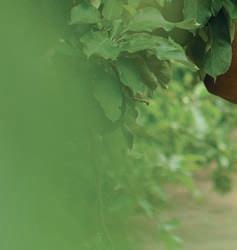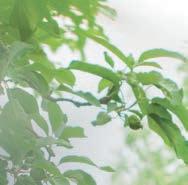grapefruit star






Up Front
Chief Executive:
social
Levy at Work
resources
is







Chief Executive:
social
Levy at Work
resources
is
Little red gem sizing up
New Zealand orchards
Taranaki branches out
pressure on lease
supply
Technical
Apple reproduction – from buds to flowers
regular advertorial section of new products and services. This publication does not endorse the products or services featured here.
Gypsum – an orchardist’s friend
guide to New Zealand’s
growers’
and
fruit” the star in Gisborne orchard’s citrus line-up

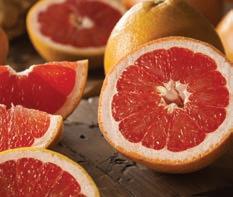
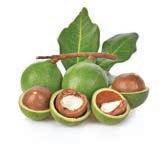
rainfall dampens
growers’ winter harvest
leaders programme
workers
Trial to triumph for Waitakere
orchard
Women leadership trio help
sector prosper
ADAMA New Zealand –BreviSmart® – Web-based thinning prediction tool moves to the next level
Fieldays Innovation Awards
– Growers encouraged to enter their ideas for these Awards
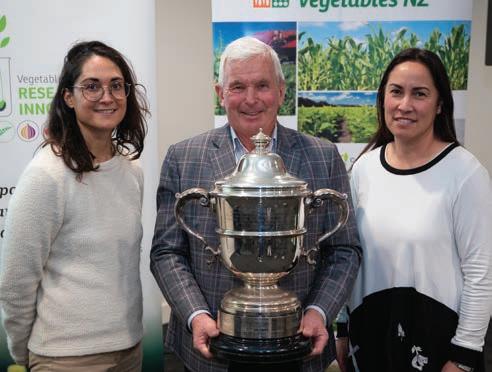
What do we think of as horticulture’s greatest risk? Is it the inability to have confidence of future labour needs? Maybe it’s not having reliable water access, or the risk of inflationary input prices? Or maybe even disjointed and illogical government policy?
Barry O’Neil : HortNZ presidentAccording to our primary sector leaders, these risks are not the most significant ones. Once again and for the twelfth year in a row, Ian Proudfoot’s Agribusiness agenda has identified biosecurity as our sector’s biggest risk.
For the last twelve years we have consistently identified that our number one priority for the primary sector is wanting New Zealand to have a world class biosecurity system –or ideally the best biosecurity system in the world.
In my opinion, we already do have a world class biosecurity system, which over my career I have been fortunate to be part of. We just have to travel to other countries where few or no biosecurity checks occur on arrival to understand the efforts New Zealand makes to keep out unwanted pests and diseases.
But if we have a world class biosecurity system, then why do many in the primary sector get wound up about Foot and Mouth disease being found in countries such as Indonesia?
Our number one priority for the primary sector is wanting New Zealand to have a world class biosecurity system – or ideally the best biosecurity system in the world
Foot and Mouth disease (FMD) in livestock is akin to the Queensland fruit fly in horticulture. In 2003, the Reserve Bank estimated the impact of a medium FMD outbreak in New Zealand would be in the order of a $10 billion shock to the economy over two years.
The disease decimated United Kingdom farms in 2001, with more than 750 individual outbreaks forcing the UK government to slaughter and burn more than a quarter of a million animals.
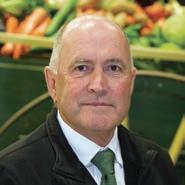
So, it is understandable that some of industry worry when something like FMD comes onto our radar. Sometimes concern turns into criticism of our country’s biosecurity efforts, which is totally unfounded for many good reasons:
Firstly, FMD is endemic in many parts of Asia, West Eurasia, the Middle East and Africa, which means that a big part of the world has it already, and for decades. Every day there are people and goods arriving in New Zealand from regions that have FMD, not just when a country close to us like Indonesia has a problem with it. The Ministry for Primary Industries’ (MPI) biosecurity team and their predecessors have had to manage the risks, and continue to do so.
They have been 100 percent successful so far, as New Zealand has never had an outbreak of FMD.
Also, let’s not forget it is not MPI that are importing the produce or attracting the tourists and workers to come to this country. They are not the ones creating the risk. Rather they are the ones that have been tasked with mitigating the risks that others continually create.
We as New Zealand travellers, or as businesses importing goods, are creating the risks and we therefore need to take personal responsibility for that. This should be part of our DNA, requiring with our purchase contracts that the goods must be clean and sometimes fumigated, or if we are travelling that we are not bringing back risk items with us. We should also take care that our shoes and clothes are not presenting risk at the border.
When I hear criticism that MPI are not doing their job properly, I struggle to understand what is being claimed and why. Yes, we are all human. Mistakes happen and we learn from them. But do people really think our biosecurity workers aren’t committed to their task, or that they don’t take pride in the work they do day and night to keep pests and diseases out of New Zealand?
Biosecurity encompasses more than just managing risks at the border. We also need good surveillance to find and then eradicate pests and diseases that do slip through the net, along with pest management to minimise impacts if something does establish here. We do have all these components, and these are world-leading as well.









In reality, we need to be a biosecurity team of five million –which is all of us, not just the MPI workers at the border. We all need to be biosecurity aware and continually doing our bit to keep pests and diseases out, while also being on the lookout for things that will very occasionally slip through the net. There is no such thing as 100 percent security against anything in life.

In reality, we need to be a biosecurity team of five million – which is all of us, not just the MPI workers at the border. We all need to be biosecurity aware and continually doing our bit to keep pests and diseases out
Editors:
Emily Pope
Ph: 027 617 6200
Email: emily.pope@hortnz.co.nz
Andrew Bristol
Ph: 021 021 62 021
Email: andrew.bristol@hortnz.co.nz
Advertising Manager:
Jackie Enright
Ph: 04 494 9986
Mobile: 0274 489 913
Email: jackie.enright@hortnz.co.nz
Design:
Scenario.co.nz
Ph: 04 385 9766
Email: joy@scenario.co.nz
Subscriptions:
Email: info@hortnz.co.nz
AT WORK
This publication uses vegetable based inks and environmentally responsible paper produced from Forest Stewardship Council® (FSC®) certified, Mixed Source pulp from Responsible Sources.
Paper produced using Elemental Chlorine Free (ECF) and manufactured under the strict ISO14001 Environmental Management System.
This magazine is posted in an EcoPure plastic sleeve. EcoPure accelerates the biodegradation of treated plastics in microbe-rich environments. Plastics made with EcoPure are biodegradable in aerobic and anaerobic environments.
While horticulture is not directly impacted by FMD, it would be indirectly impacted as would all of New Zealand. With internal movements of many risk activities stopped, the rural economy would grind to a halt, tourists – including backpackers just as they are starting to come back into the country –would cancel their travel, and many of our trading partners would ban New Zealand products – not just animal products.
Queensland fruit fly is an equivalent risk for the horticulture sector as FMD is for the livestock sector. It is not that other countries don’t have fruit fly –Europe and Asia do – it’s just that they don’t have the Queensland fruit fly. Markets would react immediately to stop trade in fruit and veggies from NZ if the Queensland fruit fly became established here. Australia has worked for decades to get markets to open for its horticulture products, with some success, but often requiring
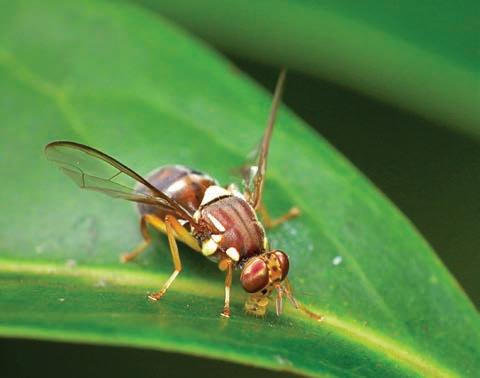
treatments such as methyl bromide or irradiation before trade is allowed – not something we would want for our high quality, nutritious, fresh produce.
We are more dependent on the primary sector and its exports for economic prosperity than any other developed country in the world. Collectively industry needs to make biosecurity one of its top priorities – just as it has been the Agribusiness agenda’s number one priority for the last twelve years.
Ngā mihi.
We are more dependent on the primary sector and its exports for economic prosperity than any other developed country in the worldThe Queensland fruit fly is a risk for New Zealand’s horticulture sector

Wet weather continued to affect vegetable production across the country, particularly the Nelson region which declared a State of Emergency until the end of August. Fruit as well as vegetable growers were affected, with orchards turning into rivers.
Many of you will have also seen the media turn its attention to the Recognised Seasonal Employer (RSE) scheme, with a series of negative stories culminating in a feature on the TVNZ Sunday programme. We are focused on correcting this negative perception and working with the Government to improve the scheme they administer and manage.
The Government is under immense pressure because of the labour shortage across New Zealand and deepening social issues. That is perhaps why on the one hand, the Government is relaxing immigration settings and publicly offering support for the RSE scheme, while on the other hand, the Government is reviewing the scheme and involving unions.
Growers are passionate people, proud of what they do to feed New Zealanders and the world nutritious, great tasting food. However, being able to grow – use land and water, and have access to a workforce – is increasingly seen as a privilege.
As an industry, we talk about maintaining social licence –that is, maintaining our ability to grow by having the support of New Zealanders and the government to plant, pick, pack and promote.
If we were to lose our social licence, growing in this country would become a lot more challenging than it already is. Society’s requirements are ever changing as new generations come through and the attitudes of older generations change in response to what they see happening in New Zealand and the world.
The saying, ‘Do unto others as you would have them do unto you’, is often referred to as the ‘Golden Rule’ and has considerable currency in today’s society.
While as an industry we can show that 98 percent of RSE
growers are good employees, one bad employer is one too many, and not just in today’s environment. One bad employer is one too many, full stop. As an industry, we must come together and make that known.
The significant majority of you do a good to excellent job within the RSE scheme. If you are concerned about how others may be performing, let your product groups know and we will assist. Remember, the RSE programme is yours collectively to protect.
The RSE scheme is a government run scheme and the Immigration Minister is the decision maker. As an industry, we will continue to engage with the government, to give growers as much certainty as possible and to ensure that the scheme continues to deliver for the nine different Pacific nations that are part of the scheme, keeping in mind that each nation’s needs are different.
I believe that as an industry, we need to be united and clearly articulate what we need, as well as the behaviours we expect of employers in the scheme. To break up and become disjointed or start to finger point would do nothing to maintain our social licence. Indeed, I believe not acting in unison would be highly damaging to growers’ social licence.
I know that growers are under immense pressure and it is coming from all quarters, least of all the weather. But I firmly believe we must stick together, continue to promote what’s great and important about our industry and deal firmly with those – no matter how small in number – that threaten our industry’s social licence at a time when we need it the most.
Please visit www.hortnz.co.nz for up-to-date information about the AGM and related documents. A proxy form and AGM information will be provided to eligible growers by email or by post, where we do not hold an email address for voting members. If you have not received the information please contact the Board Secretary
These motions will be considered at the Horticulture New Zealand Annual General Meeting (AGM) being held at the Headingly Centre, 2 Headingly Lane, Richmond, Nelson on Wednesday 21 September 2022 at 4.00pm.
That the audited financial statements for the year ended 31 March 2022 be adopted.
Proposed by the HortNZ Board
A PDF of the Annual Report and Financial Statements will be available at www.hortnz.co.nz. If you have any questions or would like hard copies, please email board.secretary@hortnz.co.nz

That the 2022 year levy rate for the purposes of the Commodity Levies (Vegetables and Fruit) Order 2019 remain and be set for domestic sales at 0.14% of the price received at the first point of sale, for export sales remain and be set at 0.14% of the price received after the deduction of all offshore costs and for processed sales remain and be set at 0.14% of the notional process value.
Proposed by the HortNZ Board
EXPLANATORY NOTE
That the minutes of the 16th AGM of Horticulture New Zealand (HortNZ), held on 6 August 2021 at Mystery Creek, Hamilton be taken as read and confirmed as a true and correct record of that meeting.
Proposed by the HortNZ Board
A PDF of the Minutes of the 2021 AGM is available at www.hortnz.co.nz. If you have any questions or would like hard copies, please email board.secretary@hortnz.co.nz
That the President’s and CEO’s Reports for the financial year ending 31 March 2022, as published in the Annual Report, be taken as read and adopted. Proposed by the HortNZ Board
A PDF of the Annual Report will be available at www.hortnz.co.nz. If you have any questions or would like hard copies, please email board.secretary@hortnz.co.nz
The Commodity Levies (Vegetables and Fruit) Order 2019 allows a maximum rate to be set for vegetables and fruit at 0.15% for domestic sales and processed sales taken at the first point of sale and at 0.15% for export sales at the first point of sale after all offshore costs (including international freight) have been deducted. For processed vegetables and fruit the levy is deducted from the notional process value, which is defined in the Order. At the AGM levy paying growers may set any rate up to the maximum for the next calendar year. The current rate for vegetables and fruit is 0.14%. This levy funds the activities of HortNZ. The Board recommends that the levy rate be set and remain at 0.14% for the 2022 year to meet the commitments identified in HortNZ’s Budget.
That directors’ remuneration be increased by 3.5% taking effect from 1 April 2022 as follows:
Position Current Figure New Figure
Director $30,413 $31,477
Vice-President $37,775 $39,097
President $81,802 $84,665
Director fees are all inclusive; therefore, no additional per diem fees will be paid for board sub-committee meetings, and regional or industry committee meetings attended on behalf of the board.”
The Independent Director Remuneration Committee met earlier in the year and conducted a review of Director’s remuneration. The Committee recommends to the AGM that an increase of 3.5% is warranted to keep the Director’s Fees current, recognise the increase in CPI while acknowledging the current fiscal environment for grower members.
The terms of reference require the Committee to go to market every three years for a full review of director remuneration. A full review was carried out in 2021 (delayed from 2019). The Committee recommends that with the impact of covid and market challenges the Board should consider bringing forward a full report to 2023 rather than 2024. This will also pull the full review cycle back into line with the terms of reference.
That the Budget for the year ended 31 March 2023 be endorsed.
Proposed by the HortNZ Board
A copy of the Budget for the year ended 31 March 2023 is available at www.hortnz.co.nz. If you have any questions or would like hard copies, please email board.secretary@hortnz.co.nz

That BDO, Wellington, be appointed auditors for the year ended 31 March 2023.
Proposed by the HortNZ Board
Proposed by the HortNZ Board
That the Rules be amended by:
1.1 Deleting from clause 2, the words “Level 2, Huddart Parker Building, Post Office Square” and inserting in their place “Level 4, Kiwi Wealth House, 20 Ballance Street”.
1.2 Deleting clause 8(a) and inserting in its place the following clause:
(a) “A general meeting of all members of the society, called the “AGM”, shall be held in each year:
(i) not later than 6 months after the balance date of the society; (ii) not later than 15 months after the previous AGM, by a quorum of members: (iii) being assembled together at the time and place appointed for the meeting; or (iv) participating in the meeting by means of audio link, audiovisual link, or other electronic communication; or (v) by a combination of both of the methods described in paragraphs (iii) and (iv).”
1.3 Deleting clause 9(i) and inserting in its place the following clause:
“
Quorum: Thirty-five (35) members present in person, or participating in the meeting by means of audio link, audiovisual link, or other electronic communication, or present by proxy shall form a quorum at all AGMs and other general meetings of the society.”
The reasons for the three proposed changes are: Amendment 1.1 – this amendment updates clause 2 to refer to the current registered address of the society.
Amendment 1.2 – under the current Rules, the AGM must be a physical meeting. This amendment provides that annual general meetings may be physical meetings, or online meetings, or a combination, to enable as many members to attend as possible. The amendment also clarifies the dates by which an annual general meeting must be held (and reflects the new Incorporated Societies Act 2022).
Amendment 1.3 – the current Rules require 35 members to be present in person for a quorum. The amendment relaxes the quorum requirement to 35 members, present in person, online or by proxy. The amendment is proposed because it better reflects the manner in which meetings might be held in future, and avoids the risk of the annual general meeting being inquorate.
If you require further information about the AGM or would like a hardcopy of any of the AGM documents, please visit our website www.hortnz.co.nz, call us on the HortNZ free phone 0508 467 869 or email Board Secretary, Kerry Norman at kerry.norman@hortnz.co.nz.
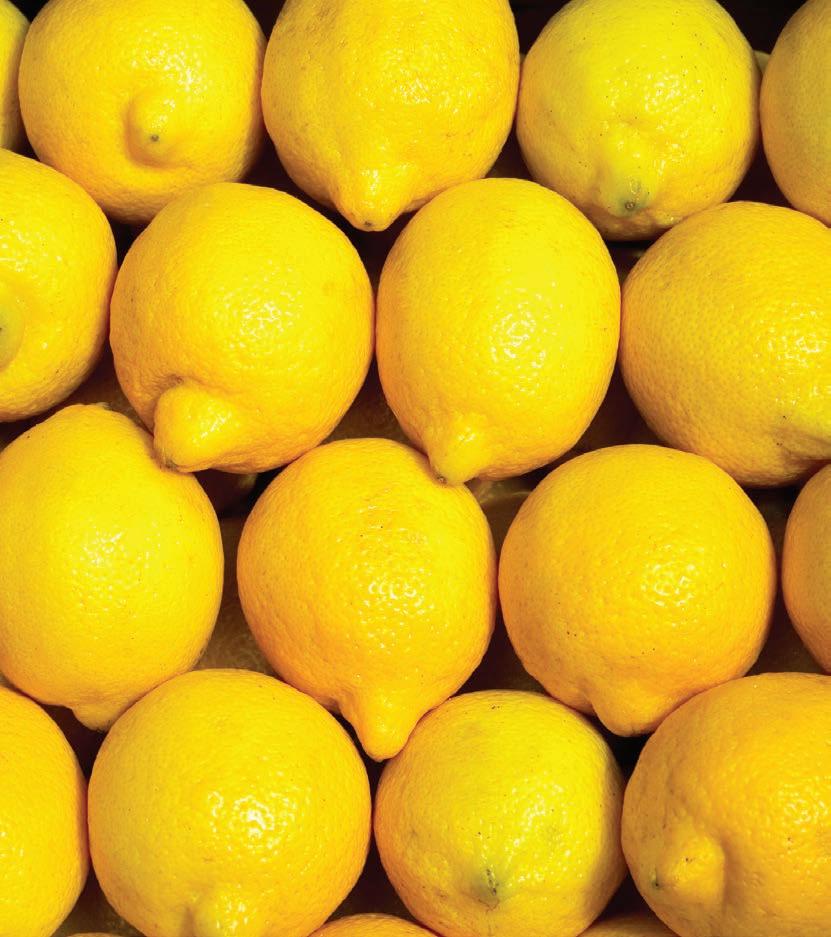




Growers, are you sick of prices dropping for your fruit or just staying stagnant whilst production costs continue to increase? Are you given a take or leave price from the retailer/marketing company? Then please speak up (albeit this may not apply to kiwifruit and apple growers).
One voice will get lost in the crowd, but many will be heard.
How come the marketers and supermarkets make such a good profit yet the poor grower who battles mother nature and who actually grows the fruit get the very least? With labour prices as high as they are, even the pickers are making more money at times. It’s widely said that supermarkets are making $1m a day!
The marketers need to hold their prices and not keep dropping them to below cost for the grower. Demand that prices increase for your fruit!
Growers’ production costs are up 30 percent and yet this year the price for some of our local fruit has even dropped. The prices in the supermarkets don’t reflect what they are paying, or should I say, fleecing the grower.
So, if we are receiving less, why are they charging so much? We are getting robbed and enough is enough. Everything is going up so why aren’t the growers’ prices going up to compensate our extra costs too? We’re not
asking for a lot, just a starter of 50c per kg more (which would help ease pressure, not necessarily answer all our prayers or not by any means make us rich).
So, if something is $3.49 per kg it would be $3.99 per kg. It wouldn’t be a huge jump to the consumer. We are getting the wool pulled over our eyes and we all need to make some noise!


I don’t condemn the supermarkets and marketers for making a good profit, but the growers need to make money too and they just need to understand this.
Growers, please email the people you deal with i.e., retailers and marketing companies and express your concerns. Also send an email to both the Labour and National Ministers that hold our relevant portfolios.

Considering its elections next year, I would email both parties in case there is a change of Government in 2023.
For the little returns we are getting I feel growers are working as modern-day slaves. So, if you want change, please speak up … and let’s get heard!!

Signed,
Letters to the editor are the sole opinion of the contributor. If you would like to submit a letter to the editor, email your commentary to: info@hortnz.co.nz
Growers Need to Make Money Too
in
 Ailsa Robertson : HortNZ environment policy team leader
Ailsa Robertson : HortNZ environment policy team leader
In the heart of Appleby near Nelson, is the headquarters of one of the largest vegetable operations in New Zealand. Founded in the 1970s by John Ewers, JS Ewers continues to operate on the original Blackbyre Road block, where produce is still grown by hand, 365 days of the year.
Under the umbrella of Market Gardeners (MG), JS Ewers grows 19 product lines of fresh vegetables outdoors on 250 hectares and nine product line crops indoors in 13-ha of glasshouses. All of JS Ewers’ produce is bound for the New Zealand market.
In early August, JS Ewers invited the Ministry for the Environment (MfE), Tasman District Council, Horticulture New Zealand, NZGAP and AsureQuality on a tour of their site. The purpose of the visit was to demonstrate to the
Ministry and Council how growers are managing their environmental risks.
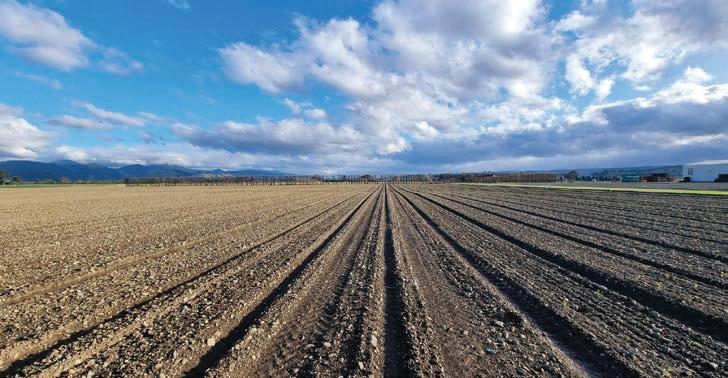
The tour was hosted by general manager, Pierre Gargiulo, and crop production operations manager, Dan Manuge. Pierre and Dan demonstrated the level of sophistication, expertise and organisation required to grow fresh, healthy and sustainable vegetables at this scale. Growing crops year-round means a range of factors must come together in near-perfect harmony.
One critical success factor is the ability for vegetables to rotate around the landscape. Rotation is important for soil health and pest and disease control. Planning the order of crops in a rotation is designed to minimise soil-borne pathogens that appear when the same crop or related crops are grown in sequence in the same soil. For example, brassica crops like cauliflower and broccoli suffer clubroot
disease if grown shortly after another brassica crop and the pathogens can remain active in soil for decades.
Production location and timing are carefully managed to ensure reliability of supply and to match the crop with the soil characteristics. Planning a rotation is done a year in advance as seeds and many other inputs must be ordered ahead of time to ensure availability. Much of the seed is produced in the northern hemisphere which faces supply challenges; so, it is essential to have a good relationship with seed suppliers and constantly be trialling new varieties.
but not just any leased land will do. It needs warm, free-draining soils without excessive contour, and with suitable climatic conditions – not too windy or frost prone. The land must also be of adequate size – greater than 4-ha – to allow efficient machinery manoeuvre during planting, spraying and harvest, while also having access to a reliable quantity of irrigation water and being located within a proximity of their packing facility.

Labour is another critical factor. JS Ewers employs between 140 to 200 staff depending on the time of year and offers an annual internship programme and Primary Industry Training Organisation (Primary ITO) apprenticeships to help upskill staff. Their workforce comprises of a mix of local, permanent staff, Recognised Seasonal Employer (RSE) scheme staff from Tonga, and South-East Asian refugees that have settled in the region.
Employing a team of skilled and available staff is critical to planting, growing, harvesting and packing the many lines of products grown to meet market specifications.
With strong residential growth in the Tasman region and increased competition from other land use, land availability is increasingly challenging. Over half of JS Ewers’ vegetable operations depend on leased blocks,
Like all growers, JS Ewers face major challenges such as meeting the rising cost of inputs (like fertiliser and fuel) and freight cost increases. Regardless, the product needs to be harvested in as fresh condition as possible and of optimum quality to ensure the price the grower is paid by the market is enough to cover their input costs – and to remain a viable business.
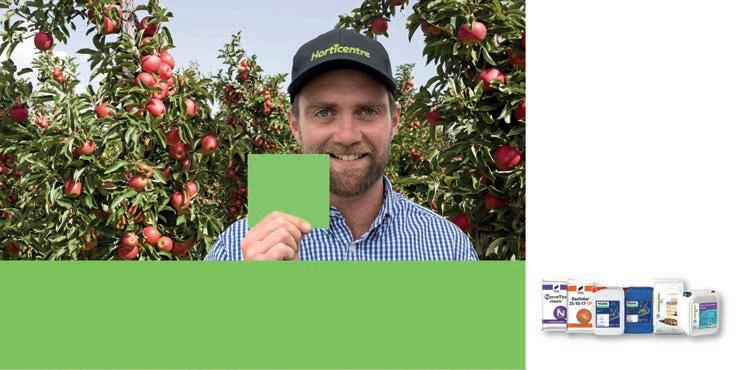
JS Ewers has made significant commitments to decarbonise their operations over time, including investing in multi-row side-dress fertilising applications and mobile irrigators to deliver exactly what the crop needs to grow
Growing vegetables is challenging and complex. As a country, we rely on the expertise of growers to balance all these factors so that we can sustain ourselves with a reliable and varied supply of fresh, local and healthy vegetables all year round.
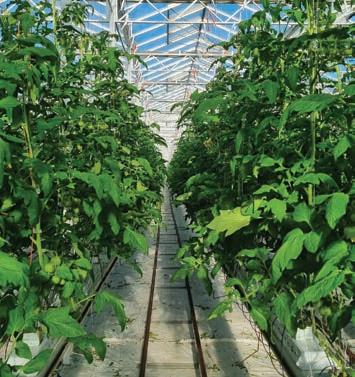
HortNZ is supporting all GAP certified growers in Waimea Plains over five hectares to develop a FWFP using the GAP EMS add-on
Pierre and Dan shared their journey of environmental sustainability to manage emissions and freshwater. JS Ewers has made significant commitments to decarbonise their operations over time, including investing in multi-row sidedress fertilising applications and mobile irrigators to deliver exactly what the crop needs to grow. Global Positioning Systems (GPS) are utilised in planting, fertilising, spraying and cultivation activities to track what is happening with their crops at every stage, from seed to shelf.
The company also manages their freshwater impact through GAP, using the NZGAP Environment Management System (EMS) add-on.
Dan says NZGAP is the company’s preferred vehicle for compliance across food safety, employment and the environment.

“It’s widely recognised by our produce buyers and integrates all requirements into one system and audit,” he says. “The EMS add-on challenged us to review our practices and identify improvements that can be made. We’re audited against the action plan that we’ve set ourselves, so it’s not just another box-ticking exercise.”
The EMS directs growers to assess risk of sediment, nutrient and water loss on-farm and manage risks appropriately based on their activity and local environment. The EMS has a toolbox of practices to manage risks from horticulture, based on research, field trials and grower knowledge. For example, using precision agriculture is best practice and growers choose appropriate, cost-effective methods and technologies for their operations to achieve the outcomes.
HortNZ and NZGAP are advocating for the GAP programmes to be recognised in new Freshwater Farm Plan (FWFP) regulations being drafted by MfE. The regulations will capture horticulture operations with five or more hectares and mixed land use with 20 or more hectares. It is expected these regulations will become operative in some regions in early 2023.
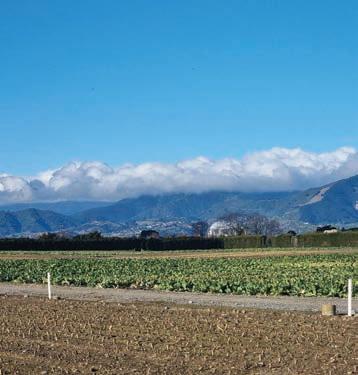 JS Ewers has one of the largest vegetable operations in the country
JS Ewers’ Nelson site holds 13-ha of glasshouses
JS Ewers has one of the largest vegetable operations in the country
JS Ewers’ Nelson site holds 13-ha of glasshouses
On the Waimea Plains, HortNZ is working with Tasman District Council to agree on the water science and how horticulture is represented in their freshwater modelling for Tasman’s 2024 plan change. The plan change will implement the National Policy Statement for Freshwater Management 2020, with policies and rules to manage freshwater takes and discharges. Regional councils across the country will be initiating this plan change process in the next two years.
For the Waimea catchment, a key challenge is the level of nitrates in groundwater, from historic and current land uses. In some bores, nitrate levels exceed the drinking water standards and may affect the ecology of spring-fed streams. High nitrates in irrigation water can also affect apple fruit quality. Through the upcoming plan change, HortNZ will advocate for the value of horticulture for food security and in New Zealand’s transition to a low emissions economy when Council is considering how to reallocate freshwater in an overallocated catchment.
HortNZ is supporting all GAP certified growers in Waimea Plains over five hectares to develop a FWFP using the GAP EMS add-on. Because of the issue of high nitrates, growers need to follow best practice for nitrogen and irrigation to minimise further impact on the plain’s aquifers. JS Ewers is the vegetable case study and is helping to show Council how the EMS works for vegetables and what best practice looks like for crop nutrient budgets and irrigation efficiency.
We encourage all growers to start a FWFP now. The EMS add-on is available to all GAP certified growers, whether you are NZGAP or GLOBALG.A.P certified. When you register via NZGAP, you will receive free property mapping to start your farm plan.
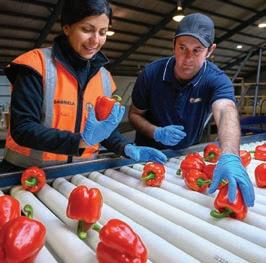
Contact NZGAP to find out more:


In this, the last of our series of articles explaining how New Zealand’s biosecurity system works, we explore what happens if someone does find something unusual on their farm and reports it to the Ministry for Primary Industries (MPI). We hope to demystify this process by explaining what may happen and why, and provide some reassurance by outlining the support available to growers affected by an unwanted pest or disease.
Key points:
Rapid reporting of unusual things saves livelihoods.
The Ministry for Primary Industries (MPI) requires information to investigate the scale of the hazard that is being reported and assess how it can best be managed.
Under the Biosecurity Act 1993, MPI has the legal authority to contain and control unwanted pests and diseases within New Zealand.
Industry product groups work with MPI throughout this process and are here to support you.
The current compensation laws provide that growers are likely to be entitled to compensation where MPI has exercised powers under the Biosecurity Act and a verifiable loss has resulted.
Growers play an important role in the country’s pest and disease surveillance system. As growers, orchardists and packhouse operators, you are the eyes and ears of the biosecurity system and you hold huge knowledge about what is normal. When you see something that does not look quite right, reporting it protects your own enterprise, the wider industry, and (in some cases) New Zealand as a whole. However, anyone who has been directly involved in a biosecurity response will know that reporting can set off a cascade of pretty stressful events. It is easy to understand the temptation to turn your back and pretend you have not seen anything. Unfortunately, this inaction could cost you and the wider industry more pain in the long run, as it increases the unwanted invader’s chances of establishing in New Zealand and becoming part of the horticultural landscape. Think higher pesticide costs, market access risks,
loss of premiums, reduced yields, or poorer quality produce.
There are currently two methods you can use to report to Biosecurity New Zealand (the biosecurity branch of the Ministry for Primary Industries (MPI) directly: phoning the pest and disease hotline (0800 80 99 66), or using a new online reporting tool: http://report.mpi.govt.nz/pest
An alternative option is the Find-a-Pest app for insects and weeds. This app allows users to post photos of oddlooking pests for identification by other users. Pests that are identified as potentially being unwanted in New Zealand by designated experts are then reported to Biosecurity New Zealand for investigation. Whichever method you choose, you need to catch the pest, take a photo of it and ideally hold it in a secure pottle. If the thing you have spotted is unusual disease symptoms in a plant, tree or fruit, good quality photos will also be extremely valuable. When Biosecurity New Zealand receives a report, they require information to be provided to help them determine what this unusual thing is. You will be asked for your contact details and for some initial information about the thing you have seen. You will then be contacted by a pest and disease specialist from Biosecurity New Zealand who will discuss your finding with you. They will want to know how many insects or diseased plants there appear to be, will request some good quality photos, and they will explain to you how to send them samples, if you have some.
If the unusual thing does not turn out to be an unwanted biosecurity risk, then no further action will occur. However, if the specialist thinks this could be a suspected biosecurity risk, then Biosecurity New Zealand will start an investigation.
An Incursion Investigator will likely visit your property. The Investigator will gather information from you as they try to piece together the jigsaw of how the possible pest or disease may have arrived on your property, when it was likely to have turned up and where it may already have moved on to. This information is important as it helps them build a full picture of the size of the issue and what options may or may not be available to manage this situation. Good farm records are invaluable during this time.
The sorts of things Biosecurity New Zealand will want to know are what plants or plant materials have come onto the property in recent weeks, who has visited the property
(including contractors) and where have plant material or products been sent to from the property. This is very similar to the Covid-19 tracing activities that we have become used to. The Investigator is trying to map the movements of the pest and disease so that they know where to direct efforts to prevent it from spreading too much further.
Under the Biosecurity Act 1993, MPI has the legal authority to do what is required to manage this potential risk. Depending on the issue, they may set traps on your property and your neighbours’ properties, and they may put legal restrictions in place to prevent risk items (such as infested or infected plants or products) from leaving the property. These restrictions may also limit the people and machinery coming onto your property.
Being the focus of an investigation like this is stressful, but if you find yourself in this situation, industry groups are here to provide any support or help that you may need. Please do pick up the phone at any time to ask us questions or request support.
If this investigation does identify that an unwanted pest or disease is present, then a full biosecurity response may be launched to either attempt to eradicate the invader completely or to minimise the negative impacts by controlling and managing it. We’ve seen both of these strategies used during the different stages of New Zealand’s response to the global Covid-19 pandemic.
The actual actions Biosecurity New Zealand will use to control the invader will depend on what it is, but generally movement controls are put in place to stop it from spreading off your property while it is being managed. These movement controls may be applied to people, plants, products or vehicles. Traps may continue to be set and monitored. Treatments such as pesticides may be used, or plants infected with contagious diseases may need to be destroyed and disposed of in a way that avoids
spreading the disease further. Good hygiene practices, usually including disinfection, will be required across your property throughout this process.
While no one can compensate a grower for the general stress and sleepless nights they will experience being involved in a biosecurity response, the Biosecurity Act 1993 does currently provide a good economic compensation package for people who suffer economic loss due to Biosecurity New Zealand exercising powers under the Act on their property to control a biosecurity risk. Generally, the Act provides payment for losses suffered due to damage or destruction of property or movement restrictions on items. The legal aim of the current compensation package is that no one directly impacted by MPI’s actions under the Act should be left in a better or worse position. This does require an affected grower to submit a claim for compensation that is supported by verifying documents. Make sure that your farm records do support the size of the claim you are submitting. MPI’s website has more information about what is eligible for compensation and how to submit a claim.
This draws our series of biosecurity articles to a close. Biosecurity is a complex area and the risks posed to New Zealand’s horticulture sector by unwanted pests and diseases is likely to get larger, not smaller, in the future. However, if all New Zealanders see themselves as biosecurity champions and play their part, we can minimise the chance of biosecurity threats arriving and establishing. Working together and doing the right thing is best in the long-run for our sector.
If you have questions or concerns, please contact HortNZ or your industry body – we are here to help and support you.

MPI’s pest and disease hotline: 0800 80 99 66
MPI’s online reporting tool: Report a pest or disease | Biosecurity | NZ Government (mpi.govt.nz)
Horticulture New Zealand has been using regional events to acknowledge growers’ commitment and success this year, because the 2022 Horticulture Conference was cancelled due to uncertainties surrounding Covid-19.
Andrew BristolDanny Bearsley was awarded the horticulture Bledisloe Cup at a vegetable grower event in Christchurch in early August. The horticulture Bledisloe Cup is awarded annually in recognition of an outstanding contribution to commercial growing in New Zealand over decades.

Danny is credited with saving the Hawke’s Bay process vegetables industry in the 1990s. This industry now processes more than 5,500 hectares of produce sourced from the Hawke’s Bay, Gisborne and Manawatu regions.
Danny’s horticulture career spans more than four decades. While he diversified into growing apples and kiwifruit, and fresh broccoli in the 1990s, Danny has always retained a healthy interest in the process vegetables industry.
Today, Danny maintains his involvement in horticulture through the wine industry.
At the same event, Robin Oakley, a fifth-generation grower from Canterbury, was awarded a HortNZ Environmental Award for 2022.
Danny Bearsely (centre) was presented with the Bledisloe Cup by HortNZ vice president, Bernadine Guilleux (left), and HortNZ chief executive, Nadine Tunley, in recognition of his outstanding contribution to commercial growing in New Zealand564
solar panels have been installed at Oakley’s Southbridge postharvest site
“Oakley’s is dedicated to continuous improvement,” said Robin. “I am proud that our efforts have been recognised by HortNZ and want to share with New Zealanders the good work that is done on our farms.”

Danny is credited with saving the Hawke’s Bay process vegetables industry in the 1990s
Oakley’s Premium Fresh Vegetables grow potatoes, beetroot, broccoli, pumpkin and arable crops including
grass seed, wheat, peas and maize on more than 450 hectares. They wash, grade and pack produce on site.
In recent years, Robin has taken considerable steps to reduce, monitor and manage greenhouse gas emissions, nitrogen leaching and improve soil quality, through initiatives such as the Sustainable Vegetables System project.
In particular, Robin has looked to power usage and installed 564 solar panels at Oakley’s Southbridge post-harvest site in April this year. These 390-watt panels will account for around 40 percent of the site’s annual energy demands.




For bigger roots, higher nutrient uptake, sturdier more resilient trees and higher quantity and quality fruit.
Available from leading horticultural
is
available
organic form.
HortNZ has awarded two Environmental Awards this year.
The other HortNZ Environmental Award for 2022 was presented to MG – Market Gardeners Ltd Auckland Branch –in recognition of its commitment to environmental sustainability, at a vegetable growers’ function in Pukekohe in late July.
“MG has won the award in recognition of its real commitment to environmental sustainability,” said HortNZ President, Barry O’Neil, who presented the award.
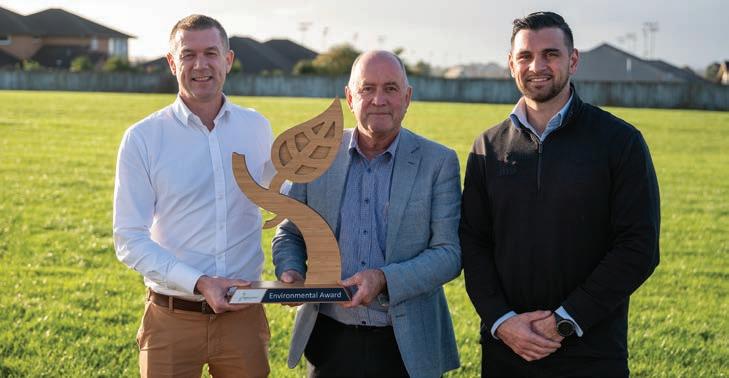
“Thanks to MG’s focus and investment, the cooperative has made a measurable long-term difference, delivering a 57 percent reduction in carbon emissions by converting to natural refrigerants, installing solar and diverting food waste away from landfill at its flagship branch in Auckland.”
Auckland branch, having worked out that the bulk of their carbon emissions came from electricity consumption, refrigerants and food waste.
“As a co-operative, we have a strong focus on making decisions today that benefit future generations,” said MG general manager of communications and sustainability, Ellery Tappin.
Two years ago, MG signed off on its first sustainability roadmap, which has set the direction and defined improvement targets. This included focusing on their
“While the sustainability projects delivered at our Auckland branch have been driven by the MG Board, management and team on-the-ground, the improved performance is delivered on behalf of the grower-shareholders who own our co-operative.
“We are particularly proud that our investment in sustainable projects is not window dressing – rather, it’s making a real, measurable difference.”
The last awards for 2022 will be presented at the HortNZ Annual General Meeting in Nelson on 21 September.
As a co-operative, we have a strong focus on making decisions today that benefit future generations
We are particularly proud that our investment in sustainable projects is not window dressing –rather, it’s making a real, measurable differenceHortNZ president, Barry O’Neil (centre), presented MG manager of communications and sustainability, Ellery Tapin (left) and MG Auckland branch representative, Marcus Gobald, with the 2022 HortNZ Environmental Award
national final will be held at the Richmond A&P show grounds in Nelson from 10am – 3pm on Wednesday 21 September.

Winners from each of the six regional Young Grower competitions will compete in a series of business and practical modules designed to test their horticultural skills, business knowledge, leadership abilities, oratory talents and more. All are encouraged to attend and support the finalists in the day’s activities.
Nelson – Meryn Whitehead (Vailima Orchards)
Central Otago – Jacob Coombridge (Webb’s Fruit)
Pukekohe – Sarah Dobson (A.S Wilcox & Sons)
Hawke’s Bay – Maatu Akonga (T&G Global)
Gisborne – Maninder Singh (LeaderBrand)
Bay of Plenty – Laura Schultz (Trevelyan’s)

The awards dinner and speech night will begin at 6pm, Thursday 22 September at the Rutherford Hotel.

Tickets are still available and can be purchased individually or booked as a group of 10.
BOOK TICKETS HERE: eventspronto.co.nz/yg22
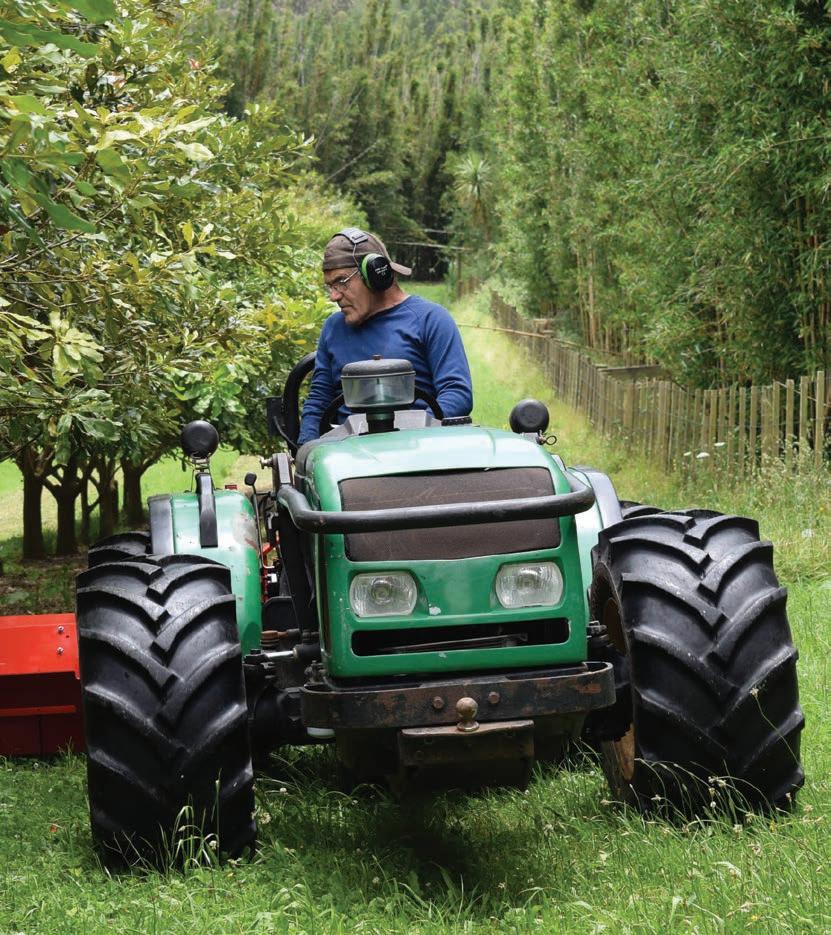
The new Zespri RubyRed™ kiwifruit variety makes up 15 percent of the Glenview Orchard near Hamilton and not only provides high returns but a continuous workflow through much of the year too. ANNE HARDIE speaks to growers of the new variety and how it is progressing.
Richard and Robyn Glenn were some of the first growers to trial Zespri RubyRed Kiwifruit – or Zespri Red as it was known initially – having trialled the first red kiwifruit more than a decade ago. PSA wiped that first trial out so they started again from scratch.
Today, they have four hectares of greenfield Zespri RubyRed Kiwifruit under canopy that is slowly but surely maturing to full production.
Sixty percent of the orchard is made up of Zespri SunGold, with Zespri Hayward adding a further 25 percent and now Zespri RubyRed
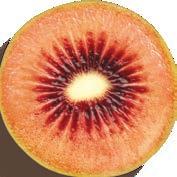
covering 15 percent. An extended kiwifruit harvest now begins in early March on the red fruit, moving on to gold and then green which together increase diversity for the business.
The Glenns began growing kiwifruit on their rolling block of land near Ohaupo 43 years ago. Richard says it was a toss-up between dairy and kiwifruit and the latter won. For years they grew apples for a time as well, but Richard says their apple crop never matched other regions such as Hawke’s Bay and Nelson, whereas they were achieving good kiwifruit results.
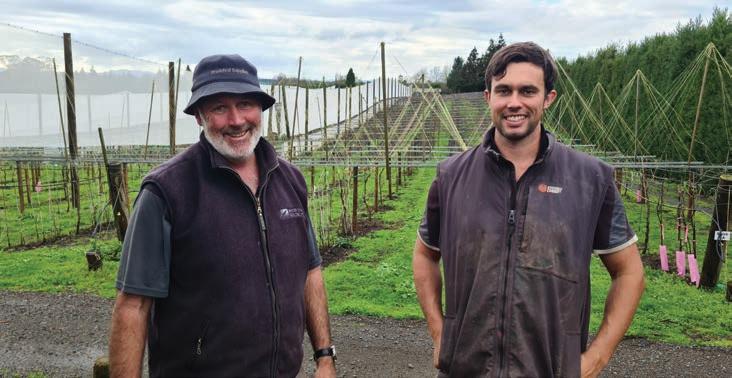 Richard Glenn (left) was among some of the first kiwifruit growers to trial the Zespri RubyRed™ variety. His son Matthew (right) is now in charge of the day-to-day running of the orchard
Richard Glenn (left) was among some of the first kiwifruit growers to trial the Zespri RubyRed™ variety. His son Matthew (right) is now in charge of the day-to-day running of the orchard
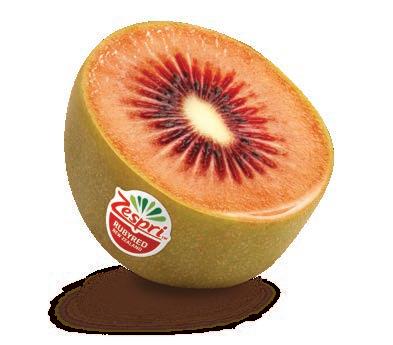

Zespri’s Plant Variety Rights (PVRs) were also a reason to gradually quit the apples and plant more kiwifruit.
Over the years they have trialled a number of kiwifruit possibilities for Zespri, which gave the kiwifruit marketer a geographical spread in its trials and a variety of growers. It also gave the Glenns an early insight into the new red kiwifruit.
Richard describes it as an orchardist’s fruit. It takes work to grow the size of the fruit and all orchard practices have to be carried out on time. That is the job of their son, Matthew, who is in charge of the day-to-day management of the orchard.
“It’s just making sure you do jobs on time,” Richard says. “Once you have a mature canopy, you need to make sure the thinning is nailed early. This variety will also need more pruning at certain times of the year.”
It takes work to grow the size of the fruit and all orchard practices have to be carried out on time
Free-draining, warm sites are essential for the variety and their own orchard sits on rolling silt-loam country. Richard says shelter is vital as well and he thinks the greenfield route with canopy is probably the best way to go to achieve warmth for the crop.
The original plantings of Zespri RubyRed Kiwifruit were spaced at 5 metres by 3.5m wide, but the Glenns then double planted them and they are now spaced at 2.5m and 3m wide.
The variety is a smaller fruit than its gold and green counterparts, though Richard expects size to increase as the crop matures and as the variety is improved over the years
“The reason for that is when we double planted them, it had bigger fruit which you can see with your eye.”
The variety is a smaller fruit than its gold and green counterparts, though Richard expects size to increase as the crop matures and as the variety is improved over the years. It takes hard work with a range of tactics to get the fruit size up. Most of it is simply good orchard management, but he says growers have to be proactive and get jobs done on time. They are targeting a 34 to 35 count for Zespri RubyRed Kiwifruit this year and he knows another orchard has achieved a larger size fruit of 32 to 33.
“In the next ten to 15 years they will produce better versions and we’ll get the fruit size right and crop size right,” Richard says.
The fruit may be smaller, but returns are high. Richard says the three varieties now provide ten months of work for their contractor’s staff.
Zespri RubyRed Kiwifruit starts the season with bud burst between 20 and 25 August. By the time they begin flower thinning on the variety, around 20 September, the pruning team is still working in the Hayward blocks. Just like harvest, flower thinning flows from red to gold and then green. Once completed, it is time to begin summer work
on the reds. Come early March, Zespri RubyRed Kiwifruit is the first off the blocks to harvest.
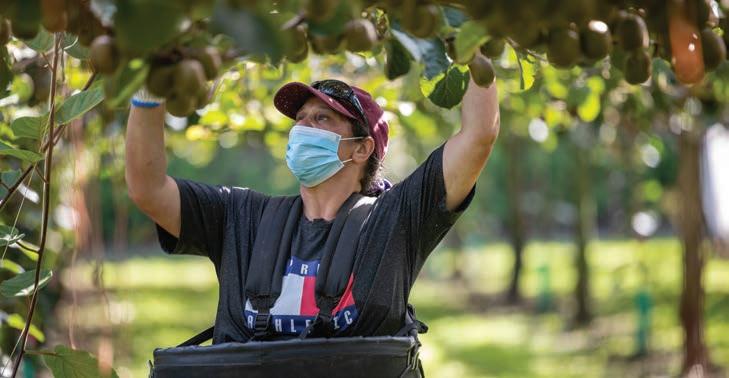

At harvest, Zespri RubyRed Kiwifruit is a little stiffer to pick from the vines and Richard says is even more important than the other two varieties to get it to the coolstore on the day it is picked. Glenview Orchard packs all of its fruit through EastPack in Te Puke and he says they work on getting the smaller kiwifruit cooling as soon as possible.
“The day you pick it you want it in a coolstore to reduce field heat,” Richard says.
The fruit itself has a vibrant red flesh which prompted its name and Richard says its taste is as different to other kiwifruit varieties as its looks.
“It has a berry taste which you can smell and taste,” he says. “I give it to people and they go ‘wow!’”
This year was the fourth crop of Zespri RubyRed Kiwifruit out of the orchard.
Richard says growers can expect full production from a greenfield orchard in four to five years, whereas grafted Zespri RubyRed Kiwifruit will get there in three to four years. Their own crop is still coming onstream and he expects to produce up to 11,000 trays. It will not match Zespri SunGold Kiwifruit for returns, but he says it will far exceed Hayward.
Zespri had about 105,000 trays of Zespri RubyRed Kiwifruit for its first commercial volumes this year, up from the 70,000 trays produced last year.
The variety has a shorter shelf life compared with Zespri SunGold Kiwifruit and Zespri Green which has prompted Zespri to concentrate on Asian markets because of the shorter shipping times.
This year’s crop was distributed to New Zealand, Japan, China, Singapore, and Taiwan while Zespri continues to explore growing trials in the Northern Hemisphere.
Zespri RubyRed™ starts the season with bud burst between 20 and 25 August
The fruit has a vibrant red flesh which prompted its name
Zespri had about 105,000 trays of Zespri RubyRed™ Kiwifruit for its first commercial volumes this year
Free-draining, warm sites are essential for the variety
The variety is a smaller fruit than its gold and green counterparts
The variety has a shorter shelf life compared with Zespri SunGold and Zespri Green
Growers can expect full production from grafted Zespri RubyRed™ in three to four years
Zespri RubyRed™ has a berry taste and smell
This year’s crop was distributed to New Zealand, Japan, China, Singapore, and Taiwan
It has a berry taste which you can smell and taste ... I give it to people and they go ‘wow!’
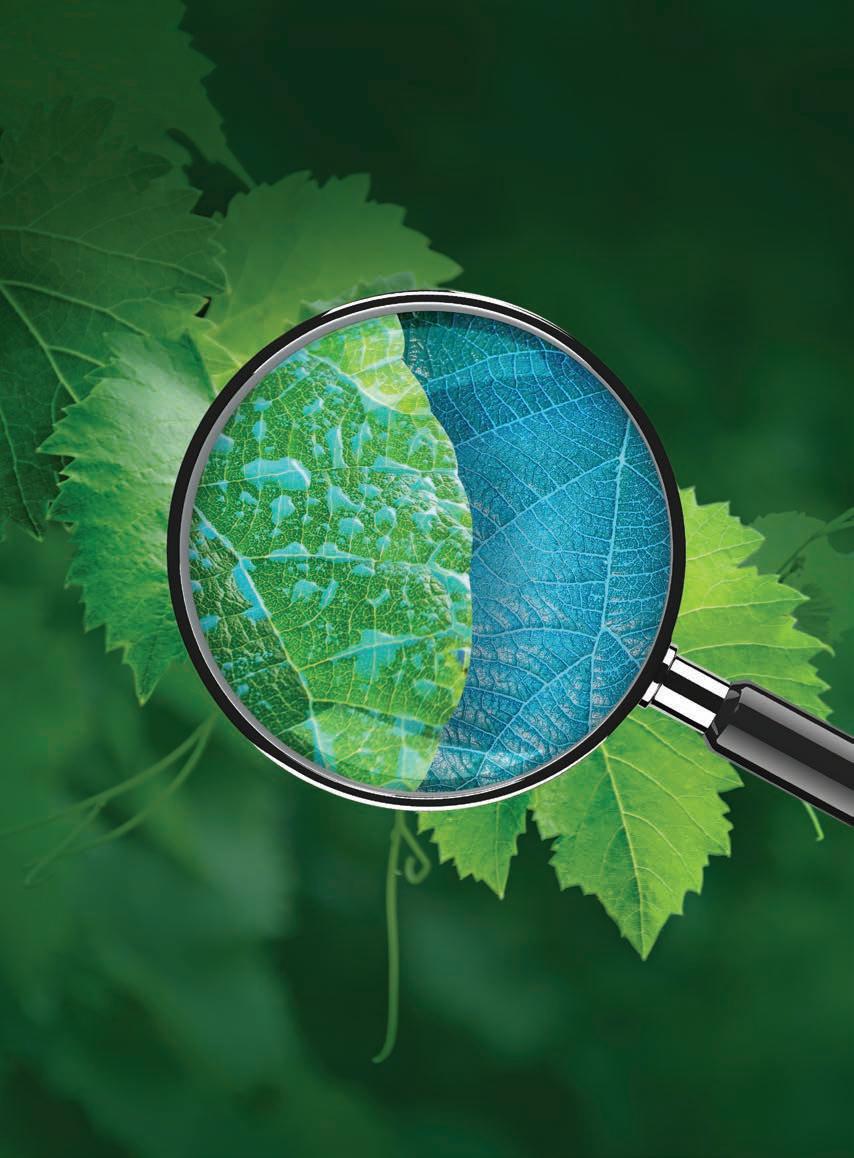

Traditionally known as a dairying region, a recent assessment of Taranaki’s land and climate has identified 270,000 hectares of land suitable for horticulture. ELAINE FISHER reports.
Research into the land’s horticultural viability is part of the Branching Out project blueprints commissioned and published by regional development agency, Venture Taranaki, which promotes nine new food and fibre investment opportunities for the district. The investment blueprints encompass innovation and growth, market potential and a path for the region to leverage its untapped food and fibre potential.
The blueprints focus on nine opportunities: kiwifruit and avocados – to diversify the region’s existing food and fibre industries – gin botanicals, grains, legumes and vegetables, hemp fibre for construction, hops, medicinal plants, sheep dairy and trees (including their value chains).
Launched in July, the blueprints contain details about sector opportunities and drivers of growth, required growing conditions, crop management, value chain development, financial assessments, and potential impact for the region – economically, socially, and environmentally.
Taranaki has been identified as an emerging growing region, with rich volcanic soil, good water availability, a temperate climate and the most sunshine hours in the country. The region is well suited for the establishment of horticulture and is attracting keen investment interest, says project lead, Michelle Bauer.
To date, 27-ha of new kiwifruit plantings are already under development and the region is seen by the industry as having potential for future growth, particularly as traditional production areas are predicted to shift due to temperature changes.

The avocado industry has shown particular interest in the region, with new orchards under development.
“We have more than 50 growers who have expressed interest in supporting pilot trial activities across a range of ventures,” says Michelle.
The nine blueprints are the culmination of extensive
Taranaki local, Matthew Hareb, has chosen to diversify his business venture by developing an avocado orchardresearch, analysis and insights provided by sector stakeholders, partners, support services and academic institutions.




Among those who assisted with identifying the opportunities are kiwifruit marketer Zespri, Plant & Food Research Limited, specialist service providers, Bay of Plenty post-harvest operators including Trevelyan’s and Apata, and national and regional nurseries.

Michelle says while regions promoting diversification is not unusual, what is unique about the Branching Out project is that it takes the value chain perspective and provides potential investors with an overview of key decision considerations – from commercial establishment, supply and value chains, potential returns, to everything in between.
New kiwifruit plantings are underway on 27-ha of land in Taranaki, including on Waitotara Orchard. Photo: Apata Group
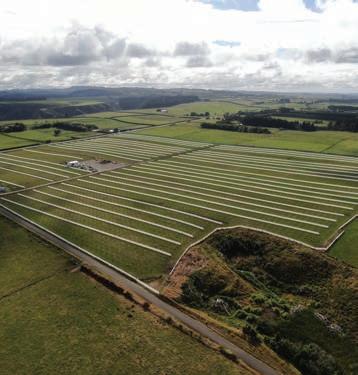
The nine opportunities the project focuses on were narrowed down from a long list of 96 suggestions.
“We decided to progress the opportunities with high-growth and strong market potential, alongside opportunities where skills, capabilities and infrastructure existed in-region already that could be applied to an adjacent industry,” Michelle says. “Among those taking up the challenge is Matthew Hareb who is developing an avocado orchard.”
“I’m Taranaki born and bred and for the last 15 years I’ve run an earth-moving contracting business in the oil and gas industry,” Matthew says. “I am now looking to diversify and see avocados as the next chapter in the book.”
Commercial plantings of Zespri Green kiwifruit have been established near Waitotara in South Taranaki and the blueprint document states there is potential for more kiwifruit development in the region.
“The region is well positioned to capitalise on this development, transferring skills and knowledge to the industry and building on the existing leadership in food and product development,” the documents states. “Prices for land suitable for kiwifruit development in Taranaki are low compared to land in established kiwifruit growing regions. “Zespri is encouraging regional diversification to meet demand and spread risks from climatic events and pest or disease outbreaks.
“There is growing demand for value-added products that can be produced from kiwifruit, and kiwifruit orcharding is seen as a viable complement to dairy.”
Michelle says of the nine opportunities identified by the Branching Out blueprint, kiwifruit, avocado and sheep dairy are likely to be the first to launch.
“All the ventures have significant market potential,” Michelle says. “In some cases, the path to market is clear, for example, with kiwifruit, avocados, or sheep dairy; so these would be considered closer to launch – particularly as there are currently plants in the ground, or sheep milk being sent to the dryer.
“In other cases, the path to market will need to be established such as for gin botanicals or medicinal plants. But in all cases, it is clear that a market does exist and future trends and consumer preferences support this.”
Michelle says among those who may decide to diversify their land use could be dairy farmers who have parts of their property suitable for horticulture.
“We are also looking for significant scale in new diversification activities, but are aware of people with smaller blocks of land between 10 and 40-ha actively looking for horticultural opportunities.”
Carefully managed land use and land diversification could have positive environmental and social impacts, Michelle says.
“We have a key piece of research around how to measure the environmental, social and cultural outcomes as industries scale up under way,” she says. “We are hoping all those involved in new ventures will take a sustainable approach.”
When the blueprints were launched in July the website traffic to the Branching Out page saw a 154 percent increase compared with the previous month, and over 1000 unique visits.

“In addition to the enquiries that we are receiving directly, we can see from our website analytics, that hemp fibre
for construction was the most visited page followed by medicinal plants, gin botanicals, avocados and sheep dairy,” Michelle says.
Venture Taranaki has called for landowners to add their details to the land use register, and registrations have increased since the blueprints launch. Michelle believes this is due to the interest in the opportunities presented.
“As we look towards the second phase of the project, there are opportunities to get involved in pilot activities and new product development – so we would encourage those interested to register their information,” she says.
The blueprints serve to build investor confidence and act as an informative roadmap for complementary land-based activities and associated value chain enterprises in Taranaki.
“The investor-ready blueprints are to be used by community including landowners, farmers, food manufacturers, growers and investors to give them all the information they need to get started,” Michelle says. “We are encouraging these groups to review the opportunities presented by visiting the Venture Taranaki website, downloading the blueprints and joining our land use registry so that we can connect them to others and share information on the ventures that are of interest.”
“Our councils are supportive of the Branching Out project and as ventures progress, we will continue to work closely together,” Michelle says.

Branching Out is managed by Venture Taranaki and a steering group of the food and fibre sector participants. The two-year initiative is funded by the three district councils in Taranaki and the Ministry for Primary Industries’ Sustainable Food and Fibre Futures fund, with significant in-kind support from Venture Taranaki, Massey University, Crown Research Institutes, and primary sector/food and fibre industry enterprises.

When it comes to apple thinning, timing is crucial –apply too early, or too late, and the results can be disastrous.
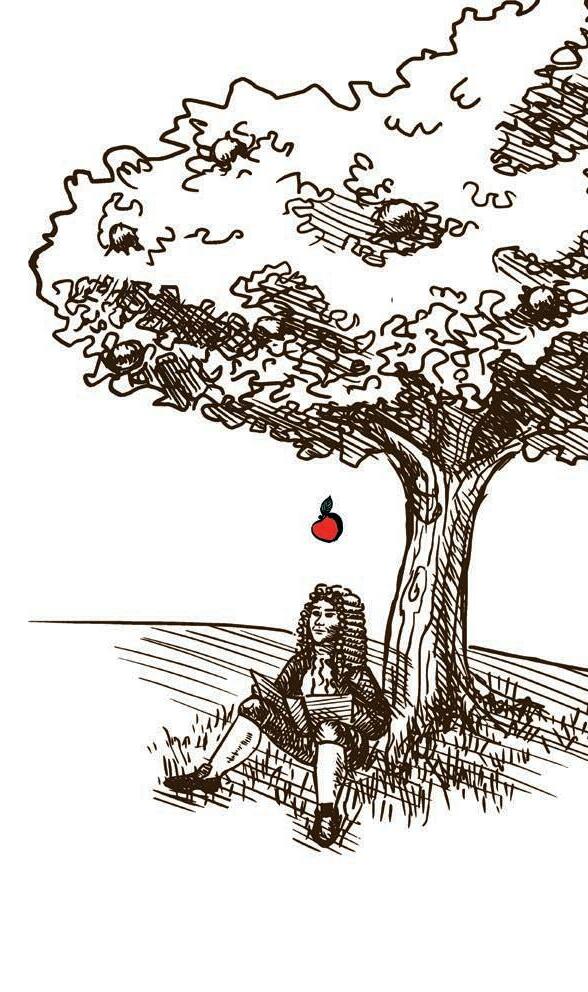
So, we developed BreviSmart to help you optimise your timing of BREVIS®
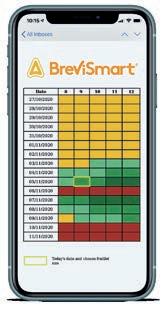


Based upon extensive local and international trials, this invaluable tool factors in solar radiation, temperature, fruitlet size and variety, delivering critical insights on the best times to spray.

“If the figures don’t add up, then you aren’t making good management decisions,” says Gisborne grower Dean Davies on the issue of finding – and paying for – land to lease
Affordability is holding lease land prices in check for now, but there is growing pressure on its availability in and around Gisborne. KRISTINE WALSH speaks to growers on how compliance and a land shortage is thwarting the future of growing.
There is a changing landscape for lessees around Gisborne as both the value of land and the cost of compliance are on the up. However, experts say there are factors at play to stop prices from getting out of hand.

For grower and Process Vegetables New Zealand board member, Dean Davies, issues around availability and compliance come before the big question of price – and that has impacted on what he grows.
In the past, Dean and his wife Sharlene have supplemented their four-hectare home paddock
with lease land to grow crops including sweetcorn, peas, maize and grain for milling.
The land they have to work with ranges from around 50 hectares to the 100-ha they are currently cultivating. But last year that figure fell to an all-time low of just 15-ha.
Because they didn’t have the land available when peas were due to be planted in September, they couldn’t take a contract with the processor they usually supply.
Consequently, Dean might not get to grow peas this year… or the next.
“All sorts of things have a knock-on effect and since one of our processor’s larger local growers is pulling back, they may no longer have the scale to make it worthwhile getting peas from Gisborne,” Dean says. “Once you lose that scale, it is hard to rebuild it.
Having grown peas for decades, Dean says it’s a disappointing reality to be facing.
“We’ve grown peas for a long time – but the loss of that big grower, plus the fact smaller growers like us might not have had land at that time, it all has an impact,” he says. “Most of our land is on long-term lease, around a decade; but we have had some patches come up for much shorter periods… say, a landowner might want just one season off grass but they don’t want to grow a summer crop themselves.
“But with the price of land having skyrocketed, they can often make more money by just going straight back into grass and grazing it. For us, that means we have had to look further afield for land, sometimes right to the extremes of our district, for plots not sought after by permanent croppers.”
It’s the technology, engineering and growercentric support that makes a New Zealand Frost Fan outstanding in its field.
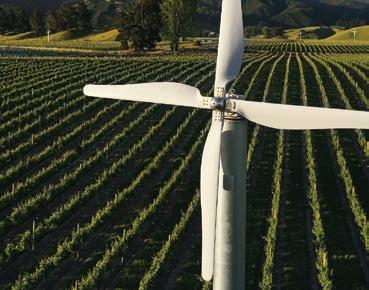

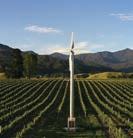
Part of the reason land prices have gone up so much around Gisborne’s fertile Poverty Bay Flats is due to interest from apple and kiwifruit growers.
“But we can’t just go out looking for land with an open chequebook,” says Dean. “If the figures don’t add up, then you aren’t making good management decisions.”
When growers do find land, they have to take into consideration Farm Environment Plans, which are now compulsory in the Gisborne district for those growing annual crops or commercial vegetables.
For Dean Davies, that means doing his own plan for longer-lease plots or working with the landowner for land available for a shorter time.
Overall, he says, the aim is to strike a balance between leasing too much land – causing costs to spiral – and too little, where a grower might not have the scale to turn a profit.
And within that, the price-per-hectare needs to be accessible.
“At the end of the day we are not doing this for love,” Dean says. “We need to make a living.
• FrostBoss® composite fan blades provide excellent coverage, fuel efficiency and low noise
• FrostSmart™ monitoring provides real time monitoring for peace of mind Dedicated, passionate team - it’s all we do

The aim is to strike a balance between leasing too much land – causing costs to spiral –and too little, where a grower might not have the scale to turn a profit
“That said, I have a passion for growing veges so will definitely stick with it.
“The increasing pressures on lease land availability and cost are just something else we are having to work through so until the prices for produce reflect that, we’re likely to be in for a bit of a tough time.”
Gisborne real estate agent, Jacob Geuze, sees Dean’s problems from the other side of the equation.
The increasing pressures on lease land availability and cost are just something else we are having to work through so until the prices for produce reflect that, we’re likely to be in for a bit of a tough time
A specialist in rural land – and from a cropping background himself – Jacob has seen vegetable and grain growers pushed aside by those working with higher-value crops.
“We’re in a situation where land prices have doubled in recent years, but lease prices have not and if they had, many lessees could not afford to pay it,” Jacob says. “So, we are kind of out of sync and that’s having a particular impact on vege growers.”
He says finding lease land around Gisborne is a long-
standing issue that has only got worse as permanent cropping has got a stronger foothold on covetable land.
“That’s tough for the lessees, but also presents challenges for land buyers,” Jacob says. “At the moment, buyers looking at parcels of land are looking at lease valuations and finding the figures just don’t stack up.
“So, they’re having to look at alternative plans, such as cropping it themselves, even if that wasn’t their original intention.”
With further price pressure on lease land likely, Jacob believes that larger growers might start looking out of the region to secure land, leaving smaller growers to take on those growing costs.
“That’s going to be difficult for annual croppers and vege growers and will inevitably have some impact for the consumer.”
At the extreme end of that small-grower scale is Gisborne man Terry Gordon, who, at the age of 75, has decided he wants to grow vegetables and flowers.
Despite having on-call advice from a relative in the industry, he wasn’t having much luck sourcing lease land through word-of-mouth so took an unconventional approach, sticking a sandwich board on the side of the road.
“I started by offering $2000 a hectare and didn’t get so much as a nibble,” Terry says. “But as I increased it bit by bit, the responses started to come in.”
 Desperate measures… Terry Gordon stuck a sandwich board on the side of the road to find lease land around Gisborne
Desperate measures… Terry Gordon stuck a sandwich board on the side of the road to find lease land around Gisborne
I started by offering $2000 a hectare and didn’t get so much as a nibble
That means Terry is paying above standard rates for the three hectares of flat arable land he has secured, but he reckons the figures add up.
“A lot of the bigger fellows have lots of extra costs in things like equipment and labour that they are locked into,” he says. “Those are costs I just won’t have, which makes it economical at that scale.”
Working out just how much is too much – or just enough –to pay for lease land is the challenge for registered valuer Carolyn Blair, of TelferYoung from Commercial Real Estate (CBRE) in Gisborne.
With qualifications in both forestry and business, Carolyn has, for years, observed shifts in rural land prices in and around Gisborne.
Working out just how much is too much – or just enough –to pay for lease land is the challenge
Carolyn points out the rate of land use change on the East Coast has in recent times been influenced by the conversion of bare land and citrus orchards to kiwifruit, apples and sauvignon blanc grapes.
Also in play is the availability of land in the region (more than in many other areas); climate conditions that offer
growers an early season and the increase in investment in horticultural infrastructure, which makes the region more attractive to developers.
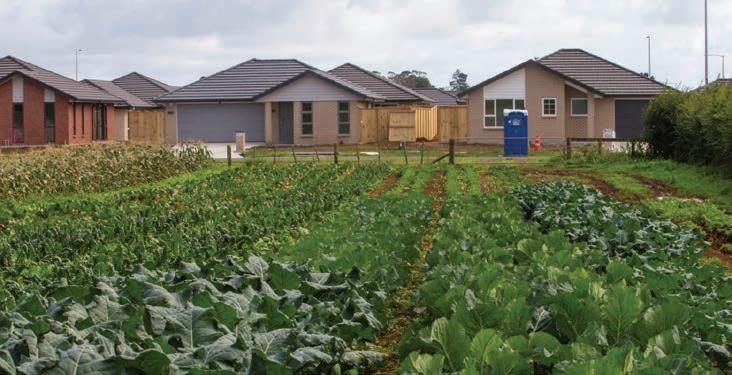
While much of her work is around hill country leases, she says there’s more pressure around leases for horticultural land. However, as the pool of lessees in Gisborne tends to be dominated by a few larger players, runaway lease prices have been kept in check.
“What we are finding is that because those larger players will only pay a certain amount, the value of leases is not moving up as quickly as you might expect given the value of flat land,” Carolyn says. “So, when working out a lease price, we have to look at it from two sides – often a percentage of land value and return on investment, as well as affordability – then try to bring the two together.”
Issues like water allocation, soil quality, or flood risk, can also impact the value of a lease, Carolyn says.
“The upside is that someone like a vegetable grower who doesn’t need a certain quality of soil, or access to water, can negotiate around that.”
Lawyers say leasing land can be a win-win. The lessor gets regular income from their land while holding on to potential capital gains; while the lessee gets access to land without prohibitive capital investment.
However, it is important for both parties that a lease agreement is clear on issues from Farm Environment Plans and crop restrictions to rent reviews and subletting.
Increasing demand for housing is decreasing the land available for horticulture operations – as seen here in PukekoheThe chair of Gisborne Produce Growers Association, Calvin Gedye, grew up on the Poverty Bay Flats – his grandfather ran stock and his father was a grower – so he knows just about every patch of land in the area and what it was used for in decades past.
But even Calvin, who is also a Gisborne grower, has found it hard to source good quality land to lease at an accessible price. This year Calvin has dropped the area he grows on to about 45 hectares, including 30-ha of his own land.
But he worries about other growers who may be forced out of the industry as they find it harder to find good patches to grow on and as the climate throws extra challenges their way.
Calvin believes winter crops in particular are under pressure as many landowners want to keep their land for winter grazing. Some are also wary of the impact that increasingly challenging weather events could have on their properties.

“The reality is you can only pay so much for a lease and we’re looking at a situation where there’s a perception that the land is becoming too valuable to grow annual crops on,” Calvin says. “I am optimistic at the moment, but long-term you have to be concerned about the future of growing. People have to eat, but in terms of the price of New Zealand-grown vegetables, they might be in for a rude shock at the check-out.”
Calvin’s own response has been to reduce the area of land he farms while increasing the diversity of produce he grows, with a focus on higher-value products.
“There was a time when we were growing on more than 200 hectares with a big focus on supplying processors, particularly with tomatoes,” Calvin says. “But we found that by the time we’d paid all the bills, we weren’t making any money. So apart from about 20 hectares of grain we’re focusing on growing vegetables for our direct consumers.”
Calvin services those consumers through his company The Tasty Vege Co and works hard to maintain the advantage he gets through his straight-to-market business model.
But he thinks it is time for the industry as a whole to be talking about how to keep the market well supplied with good quality, New Zealand-grown produce.
“The common-sense answer would be to process more to keep the freezers stocked but that’s not something we, as growers, can impose on the industry,” he says. “But it’s got to be part of the grown-up conversations we all need to be having as a nation around providing an affordable, highquality and consistent food supply.”
When working out a lease price, we have to look at it from two sides – often a percentage of land value and return on investment, as well as affordability – then try to bring the two together
 Jen Scoular : NZ Avocado chief executive
Jen Scoular : NZ Avocado chief executive



A recent Rabobank report on the Australian avocado sector highlighted a mis-matched supply and demand in that market.











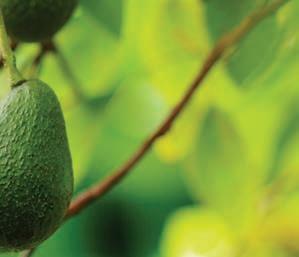
For ten years, Australia has been the highest paying market in the world for avocados, and New Zealand has enjoyed sole importer status. That changed when Australia opened their market to Chilean imports in 2020. Western Australia, which harvests their avocados at the same time as New Zealand, also had three times more volume in 2021 than the previous year.
The report talked about the crash of value and the need to develop other export markets. The New Zealand avocado sector is well placed regarding access to other markets, as growers have been investing in our export systems and in market access for a long time. That advantage meant that a third of our exports were diverted away from Australia and into Asia – markets that in the future will continue to see a much higher percentage of avocado exports.
Investment will be needed going forward to grow those markets, especially if we intend to achieve a premium over the more realistic “world price” exporters are likely to receive in Asia and perhaps in Australia. Any premium will depend on our ability to consistently deliver premium avocados to a range of markets.
Exporters are getting back into the markets too and seeing customers and assessing supply chains. The crop on the tree now will be harvested over the next six months. While it’s lower in many established orchards, there is new volume coming from some of the big developments planted over the last three to five years. We are forecasting that new volume and we may see total volume increase from eight or nine million trays to around 12 million by 2030.
New season avocados are looking good in retail and the season ahead is also looking good.
A grower I recently spoke to said that this time of year is exciting yet a little intimidating. After flowering in October 2021, avocado fruitlets formed and through this wet and dreary winter have been sizing up, maturing and taking in the nutrients that make them so delicious. But, until they are harvested and go through the pack run, growers say they never quite know how good their crop is. A lot of hard work has gone into producing the crop and a good pack-out depends on that work being done diligently and effectively.
There was some quiet expectation from this grower (and there will be from many) as they look ahead. Good returns, however, won’t come unless the hard work has been done. This includes unwavering adoption of best practice, care and attention to every aspect of production to ensure a good yield, and to ensure on-orchard costs are managed very well. It is so important for the orchardist to understand their production, see the fruit as it is being harvested and learn how to manage the trees, soil and orchard to improve both yield and quality.
Avocados don’t get stored for longer than a couple of weeks, so the harvest plan is hugely important to ensure enough avocados are picked and packed to meet market orders. That’s export and New Zealand markets, where the fresher the avocados are, the better. To supply the Australian market, exporters will be setting the harvest plan to meet the ships that get the containers to one of the Australian ports in time to feed into the retail distribution centre and the retail stores. This logistical challenge increases when sending our avocados to Asia, particularly in this very disrupted global freight environment.

One of the things Murray Burgess loves about his grapefruit crop is the fruit’s versatility. He can leave them on the tree to grow in size, he can pick them early and put them in a degreening chamber to get them ready for market, or he can have a range of varieties to harvest in winter and summer. ANNE HARDIE speaks to the boutique citrus grower about the joys of growing grapefruit.
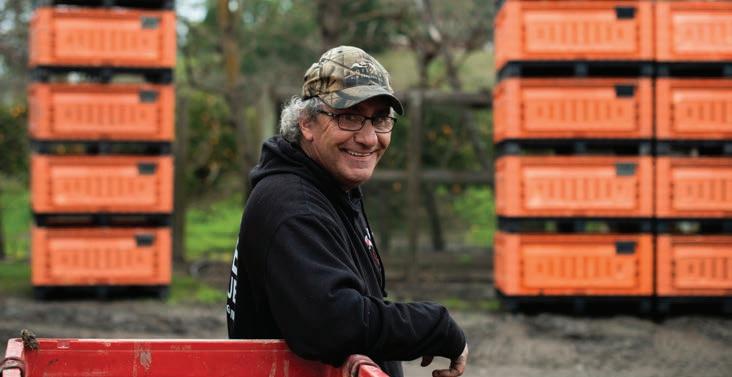
Murray and his wife, Wendy, grow 12 hectares of citrus at Te Karaka, 30km inland from Gisborne, with a mix of mandarins, oranges, limes, lemons and grapefruit. They bought Blue Willow Citrus 20 years ago because Murray had been working on a variety of orchards and wanted to “have a crack at it” himself.
“There was a bit to learn,” he says. “Anyone who says they know everything there is to know
about growing citrus is a liar.”
On the grapefruit side of the business, Murray and Wendy grow the Golden Special (Morrison variety), Cutlers Red variety for winter fruiting and Star Ruby for its summer crop.
Golden Special is an improved version of the Morrison seedless variety, producing a juicy, tangy and sweet fruit. The yellowskinned, white-fleshed grapefruit usually comes
Murray Burgess says what he loves most about the grapefruit crop is its versatility“What I like about grapefruit is you can leave them on the tree all the way through to October.”
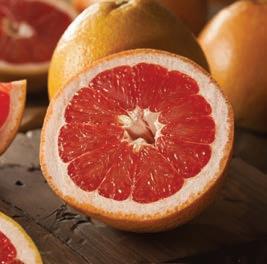
The sheer size of grapefruit fills bins fast and smaller fruit are left on the tree to size up. The market only wants grapefruit larger than 90mm in diameter, so Murray thins the fruit in autumn to grow larger-sized fruit.
Through harvest, he skim-picks the larger fruit until he has completed about five picks to get the last of the crop. Grapefruit have very little wastage because everything stays on the trees until they are big enough. Golden Special achieves zero waste as its smaller fruit at the end of the season is used in marmalades.
Through summer, Star Ruby grapefruit produces an abundant crop of red-fleshed fruit. Murray planted the variety five years ago and the trees are just reaching full production and paying their way. Despite Gisborne’s sunny climate, New Zealand is considered marginal for growing

grapefruit. It grows well in Florida, Texas and the desert areas of California but the cooler temperatures here in New Zealand means Star Ruby fruit is on the tree for more than 12 months before it is ready to harvest. Despite this, Murray says it is a crop that provides income when there is nothing to harvest from the other citrus crops.
As a summer fruit, thrips can be a pest that can be absent one day and there the next, so the crop requires spray to keep them under control. Sunburn is also an issue for the summer grapefruit, so Murray leaves sufficient canopy on the trees at pruning to protect them from the Gisborne sun.
Whereas he prunes the winter grapefruit hard after each harvest to prevent brown rot which they are prone to. Harder pruning increases air flow through the trees and lets more light in.
In all, Blue Willow Citrus harvests about 350 bins of grapefruit each year, which fits nicely into their “fruit salad” orchard and spreads the risk that comes with horticulture.
Everything is sold through Gisborne’s wholesale marketer, First Fresh. Murray says they have a relationship that works well for both parties to fill orders and get the fruit to market. He remembers when there were orchards
Murray and Wendy grow the deep orange Cutlers Red variety for winter fruitingBlue Willow Citrus harvests about 350 bins of grapefruit each year
in the region with huge grapefruit trees, but they are long gone and the industry does not have large quantities of grapefruit competing in the market. That means the price of grapefruit remains consistent from year to year at about $1.20/kg – making it a reliable income stream for the business. Managing the fruit crop through harvest helps.

‘‘Trickle feeding the market keeps the market quite buoyant,” Murray says.


He employs up to 12 locals between the end of May and October for harvesting the different citrus crops, apart from the summer-ready Star Ruby. Up to three full-time casual staff carry on through the year to help with pruning, spraying and general orchard work. Among the regulars are three generations of the same family and if Murray needs more workers, his local team finds them for him. Hence, finding staff has never been a problem and he has never needed to advertise.

“I look after them, and they look after me.”
Star Ruby
Murray Burgess surrounded by Golden Special grapefruitThe price of grapefruit remains consistent from year to year at about $1.20/kg – making it a reliable income stream for the businessCutlers Red Golden Special
Weeks of continuous rain followed by the August floods left outdoor greens in a sorry state and waterlogged soils impossible to replant in the Tasman region.
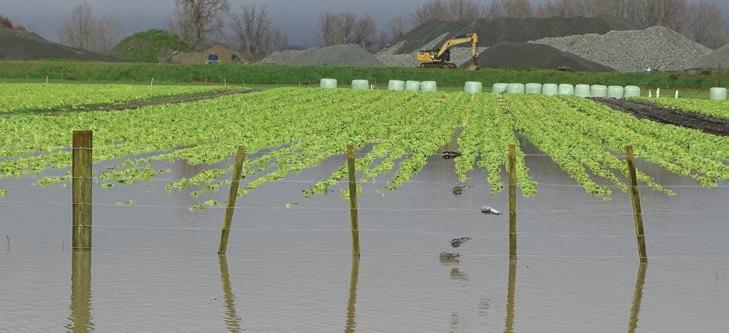 Anne Hardie
Anne Hardie
Waimea Plains Appleby Fresh grower, Mark O’Connor, measured about 400mm of rain during a four-day deluge that caused flooding and slips throughout the region. About 160mm fell on the last night, causing the most damage to the plains.
Like much of the country through winter, soils were already waterlogged before the big Nelson rain event and product was already short. Mark says they were sending product to the North Island because of shortages there – until the Top of the South got hit.
Through continual rain and flooding, Mark says the business lost a significant amount of vegetables including cabbages, cauliflowers, and lettuces. He was in the process of cutting vegetables that were still saleable, and the worst of them destined to be rotary hoed into the ground.
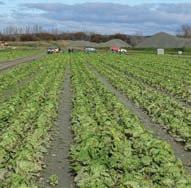
“We’ll put another crop in the ground and we’ll keep going,” Mark says. “I think we’re going to see shortages of product for a while now though – maybe [until] Christmas –because people won’t be planting. You can expect
 Lettuces under water on the Waimea Plains
Lettuces under water on the Waimea Plains
vege prices to be dearer – but still affordable.”
Between the second week of June and the region’s wild weather in August, Mark says he only had six days where conditions were suitable enough to plant – compared with the 20 to 30 days they could plant in a typical year through that same period. He had seedlings on hold from the nursery supplying his plants because the soil was too wet to plant them.
The business will take a knock, but that pales in comparison with those who lost their homes through flooding and slips.
Saturated soils, a lack of sunshine and lack of nutrients have all taken their toll on crops through winter
“We’ve lost a few vegetables, but we’ve come out better than those people in Nelson who have lost homes,” Mark says. “That must be traumatising.”
Just up the road, Connings Food Market grower, Ben Conning, had a similar story to tell.
The team usually plant new crops about three days a week through winter, but this year they were lucky to plant one day a week.
“It’s supposedly been the wettest winter on record here,” Ben says. “It’s all very well getting plants in the ground, but then you can’t get the fertiliser on, or it washes through.”
We’ve lost a few vegetables, but we’ve come out better than those people in Nelson who have lost homes ... That must be traumatising
Saturated soils, a lack of sunshine and lack of nutrients have all taken their toll on crops through winter. On the upside, prices have been strong through the season due to the lack of product available country wide.
Surface flooding is not usually a problem on the Connings’ market garden, but soils have been so saturated through winter, with a high water table, that the heavy rain event this August left vegetables sitting in water.
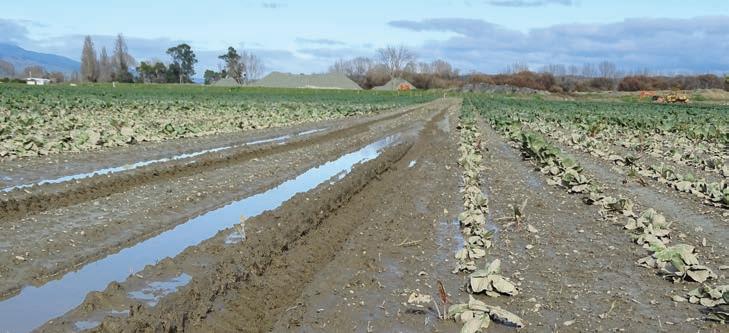
“It has been one of the most challenging growing periods,” Ben says.
The toll on crops will create holes in supply down the track. Ben says warmer spring temperatures will likely grow crops faster and accentuate those supply gaps further. Some crops will be smaller due to the wet weather and adverse conditions.
 Saturated soils after weeks of rain
Saturated soils after weeks of rain
“We wanted to get a lot more onions in the ground this winter and got just enough in,” Ben says.
Added to weather woes, Ben says labour is becoming increasingly expensive
Connings are hoping for a drier spring, though the planting window will close for some crops before that happens. Ben says the combination of moisture and heat leading into spring will likely increase humidity which is associated with higher disease pressure.
Added to weather woes, Ben says labour is becoming increasingly expensive, making it challenging to make money from lower-return crops. Going forward he expects growers will have to grow less and aim at higher-value crops to keep their businesses afloat.
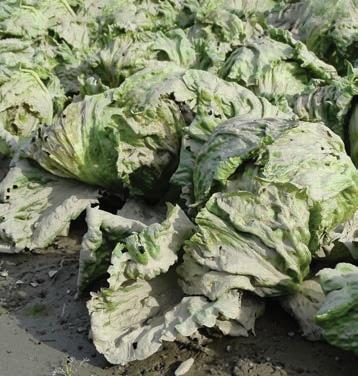
While fruit crops in the region weathered the onslaught of rain, Motueka Fruitgrowers Association chairman, Richard Clarkson, says the wet conditions have created more
opportunity for pests and disease. It will be some time before growers can assess how much stress the already waterlogged soils will place on crops.

Richards says phytophthora root rot could surface as a problem as fruit trees entered the budbreak stage in spring. Budbreak had already occurred in Braeburn and Lady in Red around the time of the heavy rain, prompting growers to get on their sprayers to protect their budding crop.
“Come thinning, apple growers will have to judge how hard to chemically thin stressed trees, while needing volume to achieve profitable returns,” he says.
Many Tasman growers produce kiwifruit as well as pipfruit and Richard says growers are now expecting their kiwifruit returns to be lower than predicted due to quality issues both onshore and offshore.
Fruit growers will need a good season next year to offset the challenges of rising labour and production costs to enable them to invest in their businesses, including turning crops over.
“We have another 12 to 18 months of quite heavy headwinds ahead for us as growers before coming out the other side,” Richard says. “Hopefully we will have a nice dry spring.”
A damaged cabbage crop after the floodwater receded Soggy and damaged. Appleby Fresh grower, Mark O’Connor, did his best to salvage what was left of his vegetable crops400mm of rain
during a four-day
that caused flooding and slips
the region
160mm
the last night,
most
plains
soils, a lack of sunshine and lack of nutrients have all taken their toll on crops through winter
wet conditions
created more opportunity for pests and disease
root rot could surface as a problem as fruit trees entered the budbreak stage in spring


Growers are now expecting their kiwifruit returns to be lower than predicted due to quality issues

we all know,
the fruit growing industry
everything stems from a twig.
have alliances with some of the world’s best new fruit variety


unique
variety
focus
relationships
and rootstock breeding
our continual search for the best cultivars puts us at the

of global variety and rootstock
Zealand.
The horticulture industry has tapped into an ‘Emerging Leaders’ development programme for some of its orchard supervisors and managers, with Central Otago becoming the first region to run it.
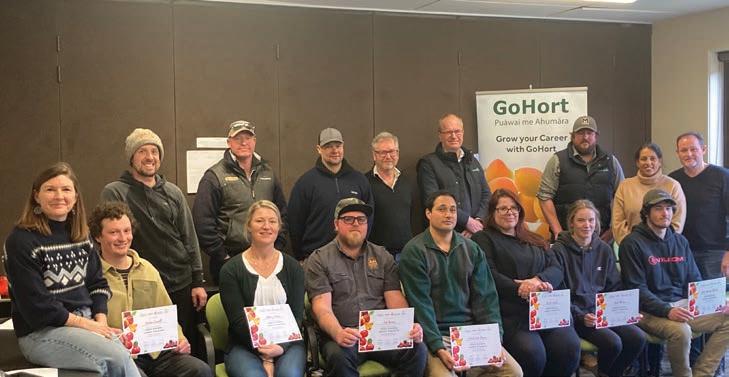
After being successfully trialled on participants in Nelson by Horticulture New Zealand (HortNZ) last year, the first ten-week programme concluded in Alexandra in midAugust and is now being rolled out into other regions. Jointly funded by Agricultural and Marketing Research and Development Trust (AGMARDT), the New Zealand Fruitgrowers’ Charitable Trust and HortNZ, the programme is on offer in Canterbury, Gisborne, Hawke’s Bay, Bay of Plenty and Pukekohe, with plans to deliver it in Nelson too.
There is a maximum cohort size for each region to ensure participants obtain the most they can from the sessions. To attend the programme, participants had to show a keen interest to become involved. Alternatively, group leaders from various orchards were put forward by their managers.
“They had to come in with an open mind and have a growth mindset,” said organiser and GoHort career progression manager, Chelsea Donnelly. “Everyone got really stuck in, it was awesome.”
Modules included emotional intelligence, developing selfawareness, managing emotions, resolving conflict, delegation and building relationships with others to lead confidently.
“There was often agreement from the participants around the challenges of the horticulture industry but also the opportunities if given the right leadership tools,” Chelsea said.
The course is run by Emerge and Transform – a leadership training and coaching company founded five years ago. New Zealand’s dairy industry has run the programme since
Participants of the Central Otago Emerging Leaders development programme2020, so the horticulture industry was a natural progression.
Course founder, Sha Perera, says the aim of the programme is to develop the tools, skills and mindset to lead with confidence.
“Leaders need to model the qualities they expect from their team,” Sha says. “This builds trust and connection and leads to stronger relationships.
“Emotional Intelligence underpins effective leadership and is integrated into the course to help participants learn about themselves and become better industry leaders.”
One participant, Lionel Boyce from Roxburgh, says he learnt how to develop more empathy as well as other useful initiatives that he could take away and think on.
“There were a lot of great takeaways from the course, all in and around self and social awareness and self and social management,” Lionel says. “My learnings from the course will help me approach difficult conversations with more confidence and [will] allow me to stay above the line [by] having a more positive mindset and by being able to recognise and understand my feelings better and relate to others.
“There’s no doubt it’s going to make me a better leader at work, a better partner at home and just a better person
in general.”
Participants were also encouraged to share some of their work issues and brainstorm solutions to these over the course of the programme – making it completely personalised.
Chelsea said there was so much she learnt from the course that could be applied not just to the workplace, but to home situations as well.
“I would often find myself using many of the tools we learnt on the daily app at home,” she says. “For example, planning tough conversations with my teenagers beforehand and engaging my ‘active listening’ skills rather than letting myself get distracted by my seemingly endless to-do list.”
The course includes daily learning ‘bites’ via an online app, three one-on-one coaching sessions and four online workshops with a facilitator.
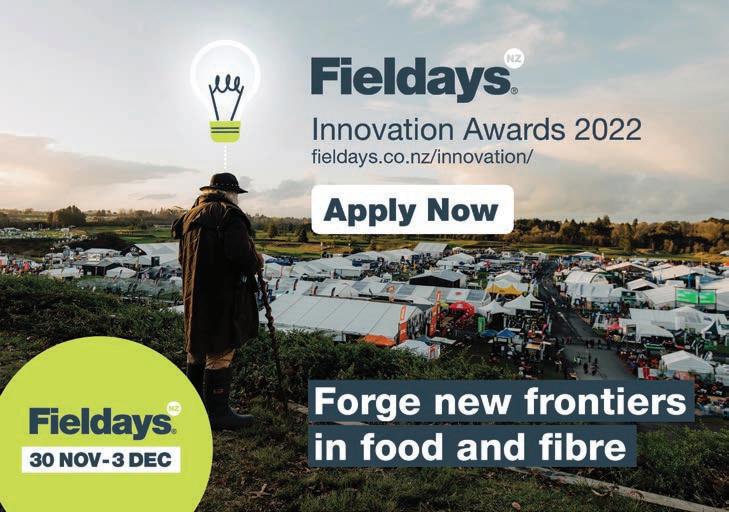
The learning and mentoring doesn’t just stop after the course either. Participants create their own specialised ‘toolkit’ to keep for future reference.
To learn more about the Emerging Leaders programme, or to participate, contact your regional GoHort career progression manager: https://gohorticulture.co.nz/leadership/
Nearly four decades ago, John Brokx and Sue Vause bought a gorse-covered block of land in the foothills of the Waitakere Ranges near Auckland. Now the land is a well-established macadamia nut orchard that produces ten to 12 tonnes each year. HELENA O’NEILL talks to the couple about their organic operation, Macadamia Holdings.
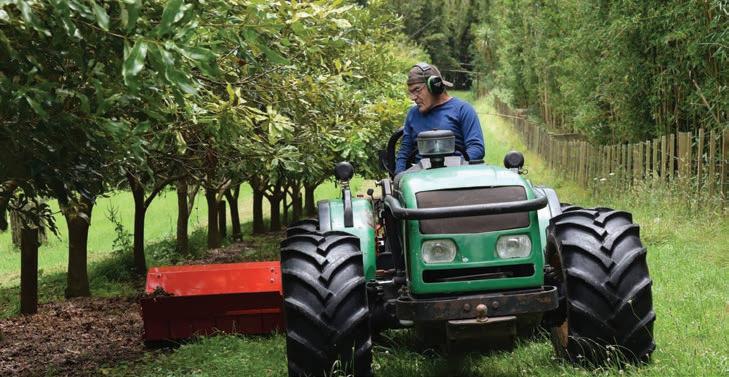
In 1984, when John and Sue bought the ten-hectare property, it was undeveloped and covered in gorse. They gradually cleared the area and planted shelter belts while both working full-time jobs.
Initially, they planted 200 macadamia nut trees as a trial, but now have more than 2000 fruitful trees across seven hectares.
“We planted a couple of hundred trees initially because we didn’t have a horticulture background and we wanted to see how the macadamias coped with our property,” Sue says.
“It was a gradual learning curve. John was in maintenance engineering, and I was doing quality control in lab work.”
Ten years into the venture, John and Sue opted to grow organically – a decision made to both improve the health
of the soil and grow nuts without compromising the environment.
Macadamia Holdings encompasses the entire operation –from large-scale growing, to processing, to marketing the finished product.
Under its Why Nut? Organic Macadamias branding, the company has evolved to offer natural (raw), dry roasted and salted, milk chocolate and dark chocolate coated nuts, macadamia nut spread (both natural and dry roasted options), bulk nuts, bird food (ground macadamia nuts and shell) and ground nut shells. All its macadamias are sold domestically.
With a focus on sustainability in the orchard, nothing goes to waste. Sue says they are always looking to refine their
John mowing the orchardoperation and become more environmentally responsible.
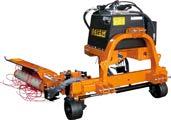

Their drying room boiler has been designed to run predominantly on orchard waste, transforming tree prunings and macadamia nut shells into usable energy. Computers monitor the drying room, ensuring both energy and cost efficiency.
Smaller orchard pruning, nut husks and chicken manure are composted and returned to the trees as mulch, macadamia nut shells are used for gardening as well as road materials, and they even make their own fertiliser.
“We were also growing feijoas, but we removed them two years ago as they were a host for one of the pests for macadamias, the guava moths,” says Sue “We were sad to see feijoas go. We haven’t got the guava moth too badly here, but we want to protect our macadamia trees.
Sue says the green vegetable bug, Nezara viridula, is the orchard’s biggest pest.
“The bug pierces through the developing shell and stains the kernel. If the damage is too bad on a kernel it will drop prematurely from the tree,” she says. “It has got worse over the last few years with the warmer temperatures. We’re not spraying as we are organic, but even some of the growers who are conventional are finding they are having a greater problem with the bugs as well.”
Regular mowing is recommended to keep the grass and weeds under control, and John and Sue also run a few Wiltshire sheep and Kunekune pigs to keep the grass down and the orchard clear of debris.
Planting macadamia trees is a long-term commitment, with trees taking between five to ten years to produce nuts. To reach full production, orchardists can expect to wait 15 to 20 years.
“It’s not a get-rich-quick project,” Sue says. “Don’t leave it until you’re retired because there’s a lot of physical work.
Thankfully, Sue says macadamias aren’t high maintenance once the initial investment and physical work is done.
“They’re a forgiving tree if you’re not putting the time in because you’re working,” she says. “There are certain things like pruning that you should do as the tree responds better if you do it, but it’s not the end of the world [if you don’t].
“Macadamias aren’t as perishable as a leafy vegetable or flower crop that you have to pick at a certain time. It’s not so critical as you have quite a wide window for the harvesting and they’re quite a stable product – you can sell them over a few years if you have stored them properly.”
The harvest season seems to be getting earlier, the couple says, starting as early as May with the last of the nuts
ripening towards October or November. Even on a single tree, individual macadamia nuts may ripen over several months.
“We harvest by hand or with a long-armed pruning tool,” says Sue. “The variety of macadamias that we have are called stickers, they stay on the tree. Some people have varieties that drop, but we are picking and stripping them off the tree.”
All seven varieties of macadamia trees on the orchard are stickers, a decision both John and Sue are glad they made given the climate and contour of their land.
“You have stickers and droppers,” John says. “The droppers fall on the ground and [as] we have quite a wet climate in New Zealand, they can easily develop fungus because you have to pick them up within a couple of days. Until you crack them open, you can’t tell the difference.”
“When you’re ready, you can pick the whole tree,” says John. “With droppers, they fall off over a period of time, so you need to go back to the tree all the time. When you have the right machinery and the right contour of the land, then droppers are easy. But most people don’t have that, and that’s when the problems come in.”
Sue says the nuts are mature when the lining of the husk is a medium to dark brown colour. When the nut is immature the lining is a cream colour.
“You can also do a test in a glass of water, remove a bit of the kernel and if it floats then the nut is mature,” she says.
“If it’s on the bottom of the glass, then the oil content isn’t high enough. Just because the nuts are dropping it doesn’t
mean that they’re ready. It could be due to insect damage or drought.”
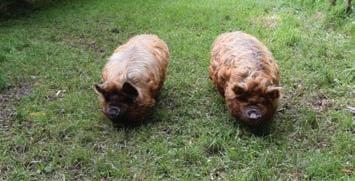
John and Sue also process macadamia nuts for other nearby growers, with some coming as far afield as Whangārei and Gisborne for their specialist organic processing services.
“It’s important to remove the green husk on the outside, don’t leave them sitting in the husks, especially in the humidity because then they will develop moulds,” Sue says. “John has built all the machinery that we have here. It’s his passion, if he didn’t have that ability then we wouldn’t be processing nuts.”
As organic growers, the decision to process their own nuts was born out of necessity as the existing processors dealt with conventionally grown macadamia nuts.

“When we originally started growing, we didn’t know anything about macadamias,” says John. “There was no society or industry body. As we grew and became big enough for a society [the New Zealand Macadamia Society] then we would go to other orchards. We went to one in Helensville and the guy running the orchard there was quite open and full of advice. But because we went organic then we had nowhere to process our nuts because they can’t be processed at a non-organic plant.”
Sue says that processing nuts for other growers at the same time their own orchard needs harvesting can sometimes be a challenge to balance because they all want to supply their markets.
Macadamia processing, the drying in particular, is extensive.

 1 Macadamia nuts have a green fibrous husk outside a hard brown shell. Within the shell is the creamy white kernel 2 Making their own seaweed-based foliar feeding fertiliser 3 Kunekune pigs help keep the orchard tidy 4 All of Macadamia Holdings’ nuts are organically grown
1 Macadamia nuts have a green fibrous husk outside a hard brown shell. Within the shell is the creamy white kernel 2 Making their own seaweed-based foliar feeding fertiliser 3 Kunekune pigs help keep the orchard tidy 4 All of Macadamia Holdings’ nuts are organically grown
Ten years into the venture, John and Sue opted to grow organically
Macadamias need to be in the drying room for a minimum of three weeks before processing – although John and Sue’s method has a point of difference.
“Some processors stipulate [the macadamias] should be partially dried to a ten percent moisture content [before they can be processed],” says Sue. “Nuts are about 23 to 25 percent moisture when they’re harvested. We don’t mind how wet they are, we just dry them. We think it’s better to get the drying process started for the quality of the kernel.”
While this is a different approach from other processors, John says it’s the safest decision for the quality of the macadamia nuts.
Nuts are about 23 to 25 percent moisture when they’re harvested. We don’t mind how wet they are, we just dry them. We think it’s better to get the drying process started for the quality of the kernel
“If we get them when they come straight off the tree and we put them in our drying room, then we know that they are 100 percent safe and with no moulds,” he says.
“We don’t weigh their [the other growers’] nuts at all until they are dry for processing. Then [when they are dry], we weigh them and count ten percent on top for the drying fee.
“For us, it’s a safeguard that we don’t have nuts that are contaminating other nuts.”

Right now, the orchard is in the middle of its harvest season. It’s a busy but rewarding time for both John and Sue as they pick their own macadamias and process those harvested by other growers.
“I enjoy what I’m doing, I don’t do it for the money,” John says. “I’m not retired, I should be, but I’m not.” John jokes that growing macadamias is a life sentence.
“You like it, or you hate it,” he says. “Once you start, it’s hard to get out. I have to think that we have succeeded at what we set out to do.”
Native to Australia, the macadamia nut is now grown in many parts of the world, including New Zealand.

It was named after Dr John Macadam, a scientist, philosopher and politician.
The macadamia nut is a member of the Proteaceae family.
The fruit tree itself is a large evergreen that can grow to 20 metres if not pruned.

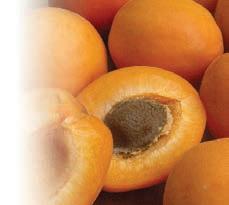
There are two edible species –the pink flowering tetraphylla and the white flowering integrifolia.

People, diversity and the opportunity to help those in the industry are among the aspects of their work that Kate Hellstrom, Andrea Crawford and Tracey Mansfield of Summerfruit NZ most enjoy.
Elaine FisherThe trio, all members of Women in Horticulture, acknowledge the past two years have been particularly hard for growers, but that has fuelled their passion to do all they can to assist growers to get through.
Kate is chief executive of Summerfruit NZ, Andrea is business manager and Tracey, labour co-ordinator. Together, with technical advisor Richard Mills, they make up Summerfruit NZ’s management team.
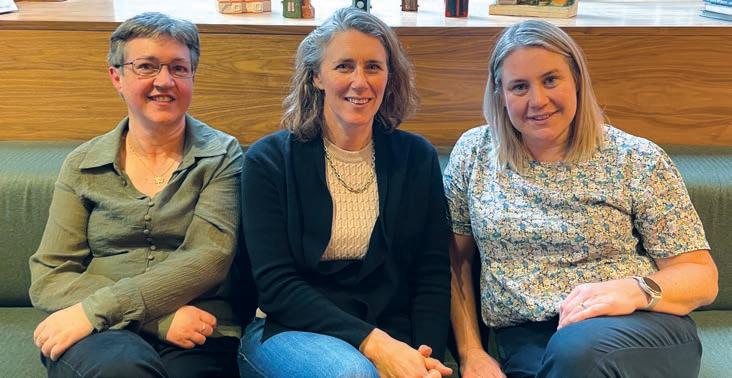
Kate, who joined Summerfruit NZ in April 2021, was raised and educated in Wellington. She has a Bachelor of Science (Zoology) from Victoria University and a
Masters in Resource and Environmental Planning (gained with Distinction) from Massey University.
Kate was attracted to her current role by the variety it offered.
“On any given day, the team will be involved in a wide range of issues including biosecurity, labour, logistics, tech transfer, export and market access, or governance – the list goes on,” Kate says. “This role requires building effective relationships with key stakeholders, government agencies and Ministers. And most importantly, this role is about people. With the rest of the team, I’m here to
The Summerfruit NZ trio: Andrea Crawford (left), Kate Hellstrom and Tracey Mansfield (right)help summerfruit growers, packhouses and exporters to prosper and grow a fantastic product that we are all very proud of.”

Kate says there have been significant challenges in the past few years.
“The horticulture industry has remained in a constant state of flux due to ongoing and complex challenges,” she says. “We’re still in a global pandemic, we are experiencing a severe labour crisis and very high turnover rates. Global supply chains remain heavily disrupted and weather events have continued to impact on all our growing regions.”

In response to those challenges, as well as working hard, the Summerfruit NZ team made quite significant changes to the way it operates. The team downsized its current staff to four, while not dropping any functions.
“We now outsource most of our administration such as finance, along with aspects of our communications,” Kate says. “We also rely more heavily on specialist contractors for tasks such as biosecurity and research project management. We have moved from our Wellington office and now work partly at home and partly in shared workspaces – in a modern, paperless, cloud-based way. [We] can easily work remotely wherever we are travelling or happen to be.”
Kate says leading Summerfruit NZ through its own changes and during uncertain times has been a positive personal challenge.
“Working closely with my very capable team of Andrea, Richard and Tracey has been great,” she says. “We support each other in our work, we take time to celebrate our successes and we check in on each other when needed.
“Our board members are also very supportive and generous in sharing of their knowledge of the industry and the unique skills and experience they each bring to their role. A big thanks to the team and the board for their invaluable contribution to our sector.”
Summerfruit NZ’s business manager, Andrea, also grew up in Wellington and has a Bachelor of Commerce and Administration and a major in Marketing and Management from Victoria University.
Andrea joined Summerfruit NZ on contract in 2018 and became a permanent employee in 2019.
“I’d known the Summerfruit NZ team for many years from my time with Horticulture New Zealand and other product

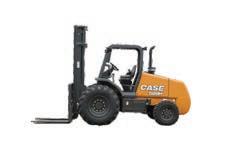

We support each other in our work, we take time to celebrate our successes and we check in on each other when needed
groups,” Andrea says. “I was keen to experience working with a developing fruit sector group.”
Andrea got into the horticulture sector in 2009 by accident when she became a part-time database administrator for HortNZ.
“I was looking for a complete change and soon got hooked,” she says. “I then moved into roles in HortNZ and vegetable product groups along with [a role] at the Primary ITO before moving to Summerfruit NZ.”
Andrea describes her current job as “the ultimate specialist/generalist role – a bit of everything.”
“I provide support to the chief executive and the rest of the team in governance, back-office management, IT support and tend to be involved in engagement with a variety of stakeholders. My role is facilitating support for the other team members and their respective portfolios.”
And it’s a role she loves.
“Where else can you work with such a wide variety of businesses and their various needs for support?” she says. “Our members include small growers, intergenerational businesses and now the emergence of larger corporates and vertically integrated operations.
“We can be talking and working with external stakeholders or members on a number of topics and issues everyday, which always keeps it interesting and challenging. It becomes personal, you know the people, their families and get to work with them and their teams on a variety of levels.”
However, it’s not always easy.
“The business environment is changing so fast these days,” Andrea says. “We have to adapt our business models and develop new ways to meet these challenges, or we simply won’t survive.”
Summerfruit’s labour co-ordinator Tracey, who now lives in Arrowtown, grew up in rural Southland, Otautau. She has a Bachelor of Physical Education and a Bachelor of Arts in Geography, with a Post Graduate Diploma in Secondary Education from Otago University.
Tracey’s role at Summerfruit NZ, which also includes some communication work and events co-ordination, was created in November 2020 in response to the labour crisis caused by the impacts of the Covid-19 pandemic.
“Horticulture wasn’t on my radar until I moved to Central Otago after spending ten years in London, Tracey says. “A desire to support the local community and being able to offer support to local fruit and wine growers during a tumultuous time was what attracted me to the industry.”

Tracey’s role involves supporting growers with their labour requirements.
“Raising the profile of seasonal work to students, backpackers, grey nomads, or anyone of working age, is what I do,” she says. “The role also includes keeping up
Summerfruit NZ is the industry body that represents the interests of over 240 apricot, cherry, nectarine, peach and plum growers across New Zealand
to date with changing immigration rules and Covid-19 protocols and building relationships with growers and a large number of stakeholders.”
Tracey too, enjoys the diversity of that horticulture brings.
“One day I can be at a university job expo, then next on an orchard in stunning Central Otago,” she says. “The variety is fantastic, from a new carbon zero orchard, to meeting with fourth generation growers, to large cooperate businesses. Seeing orchards during the different seasons is always a highlight. Nothing beats the beauty of autumn orchards in Central Otago.”
Tracey says the sector is not without its challenges though.
“Growers have been through an extremely tough time. The biggest challenge is obviously labour for them, and it’s my job to support them in finding staff. Creating more people isn’t something anyone can do, so the challenge is to find ways to help where possible.
“It is also not nice hearing from growers who are doing it tough, season after season. They all need a bit of a break.”
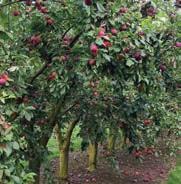
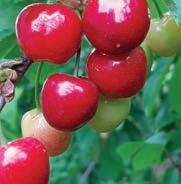
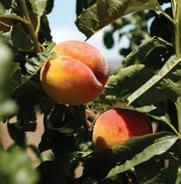
Despite the tough times the past few years, Kate, Andrea and Tracey strongly recommend horticulture as a career

for women to pursue.
“There is so much variety and career choice in the horticulture industry,” Kate says. “Everyone is passionate about their work. It’s never boring, there are always new challenges and learning and growth opportunities. I’m very grateful to be a part of this industry.”
A good set of practical skills will get prospective horticulture members a long way in the sector too, Andrea says.
“In this business you just need common sense, good communication skills, a hands-on approach, flexibility and ability to multitask,” she says. “Some problem-solving skills don’t hurt either.”
“It’s a great industry with a lot of variety,” Tracey says. “There are amazing opportunities for women, on orchard or within the wider industry. It’s fun, challenging, and always changing which makes it interesting.”

To keep up-to-date with Women in Horticulture, its news and activities and to join the membership database, email: info@women-in-hort.nz. All are welcome.

New Zealand resident: NZ$135 (GST inclusive)
Australia & Pacific: NZ$230 (airmail delivery)
Rest of the World: NZ$250 or US equivalent (airmail)
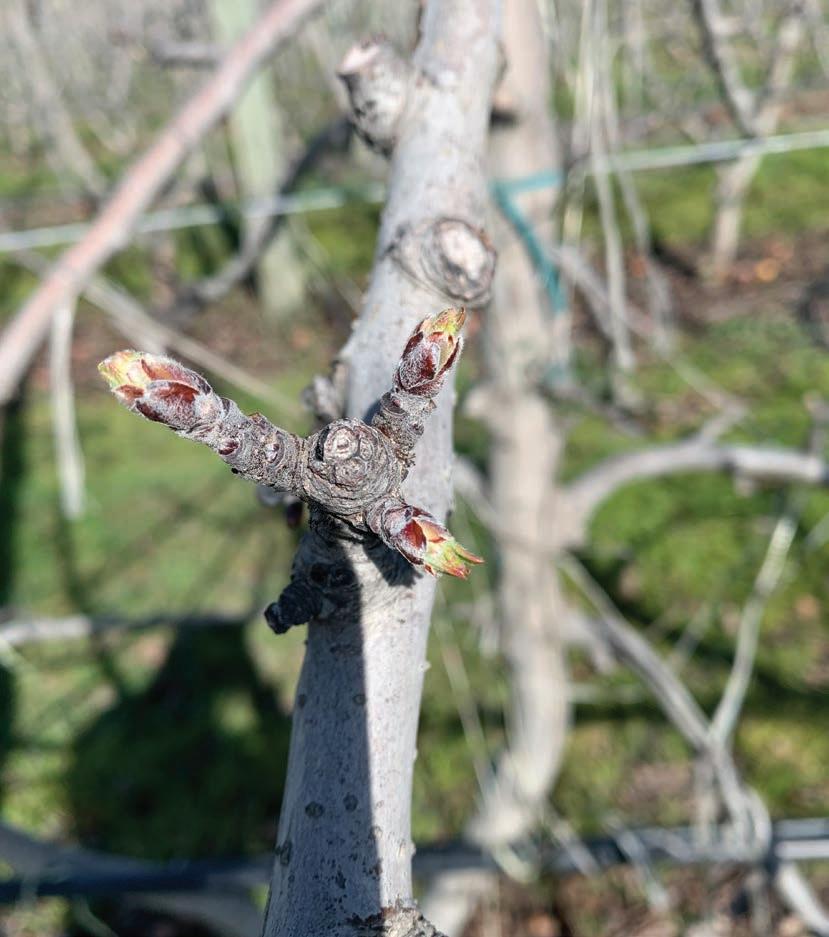
In perennial fruit trees such as apples, reproductive development takes place over a two-season lifecycle.
Sarah De Bruin : AgFirst Consultants Hawke’s BayIn the first season, a meristematic cluster of undifferentiated cells begins to form the buds we visually see along the tree branches. Within these buds, floral initiation and differentiation may occur, until the winter dormancy period. Then after budbreak in the second season, flowers emerge from the bud casing. Following pollination, the viable flowers set fruit and it is from this which we then take our crop.
Understanding this lifecycle helps us to make more informed management decisions at key timings such as pruning, flowering and thinning. Utilising plant physiology principles to guide precision farming techniques means growers can confidently achieve their target croploads and vigour management strategies, by understanding the reasons why plants react and respond in the way that they do.
Floral bud differentiation resulting in the development of flowers is the realisation of a combination of factors. The specific growth programme is directed by the internal makeup of the plant and modified by external factors such as previous seasons’ croploads, temperature and day length.1
In early spring, after the current season’s full bloom period, a meristem structure starts to develop. This structure has the potential to produce either florally or vegetatively, as the cells are not yet differentiated. If this meristem receives the signal to differentiate and develop into a floral bud, a progressive transformation of the cell structure occurs to create a distinguishably different shaping of floral primordia. This process is made up of three distinct phases.
1 Buban,T. & Faust, M., (1982) “Flower Bud Induction
Apple Trees:
Trigger signal for vegetative meristem to promote flower bud development (or supress, and remain vegetative)
Morphological changes due to developmental onset of floral structures
Development of inflorescence primordia and floral organs, pollan sac and ovules
During the first phase of flower bud induction, the undifferentiated meristem receives a signal to either trigger biochemical processes and promote flower bud development, or suppress these processes, meaning it remains in a vegetative state.
The second phase of flower initiation involves a doming and broadening of the bud apex. This is the first of the morphological changes, marking the developmental onset of floral structures and indicating that floral development is underway.
During flower bud differentiation, the third phase, the inflorescence primordia and floral organs undergo development. The formation order of this is inflorescence, flower, calyx, petals, stamen and then pistils. Thus, the differentiation of primordia is completed prior to leaf fall.2 This process is temporarily interrupted during bud dormancy before pollen sac and ovule formation the following spring prior to bud burst.3
Control
Differentiation”, Horticultural
Chunhao, W.U. et al, (2019), “Study on Morphological Differentiation and Characteristics and Flower Bud in ‘Danhua’ Pear”, J Plant Physol
Kofler, J. et al, (2019), “High crop load and low temperature delay the onset of bud initiation in apple”, Sci Rep 9, 17986.
to guide precision farming techniques means growers can confidently achieve their target croploads
phase flower bud induction,
Often the outside appearance of spur terminal buds is not sufficient to determine the presence of floral organs. During the autumn or winter months, latent buds and their fruitfulness can be visible following dissection and examination under a microscope to determine whether the bud has developed floral organs or remains in a vegetative state. At AgFirst, we have been using this precision farming technique to help our growers understand their proportions of floral and vegetative buds across different varieties of apples and pears. The correlation is high between the proportion of spurs having flower primordia in their terminal bud and the size of the next year’s crop.4 This information is then utilised along with bud counts to set bud to fruit ratios, crop targets for pruning and Artificial Spur Extinction tasks. We know that bud load and therefore flower load can affect the cropload and tree vigour responses. Getting the flower load down during pruning time, by understanding your bud to fruit ratio and pruning to a crop target, can give great gains in young tree canopy development and fruit size.

High croploads can inhibit the flower induction process, and this can lead to a poor return bloom in the following year. This reduction in floral density may be due to the concentration of plant hormones due to the fruit/seed load of the higher cropload, or lack of nutrient, as well as
a reduction in the expression of a floral induction gene in apical buds.5 On the other hand, higher bud loads can be used to control vigour, thereby reducing the risk of disorders such as pit and blotch.
Along an apple branch, three different bud types can be found: Spur, Terminal and Axillary. The terminal buds of all spurs have a similar structure, and fruit borne on terminal buds is generally heavier (bigger) than those derived from spurs or axillary buds. This is associated to a greater leaf area and therefore to photosynthetic potential driving the fruit size.
Axillary buds are under a strong vegetative influence. The shoot vigour and axillary bud’s position along the shoot are important factors in bud differentiation. Floral initiation occurs most often in the middle of the shoot. Buds which
develop on longer internodes are less likely to differentiate flowers than buds on shorter internodes, and some flower primordia on elongated shoots never reach full development. This can be attributed to insufficient nutrient supply arising from apical dominance.
Dormancy allows apple trees to survive seasonal changes and protects the meristems from unfavourable climates. Different dormancy phases can be defined based on the source of dormancy control. As the temperature starts to decrease, and the photoperiods shorten, the trees establish dormancy. This triggers the end of the growing season, during which senescence occurs and the developing buds for the following season are set.

Trees are required to meet a specific number of chilling units before they can move to the next phase of dormancy. This means they must go through a period of prolonged exposure to cold temperatures. Chilling requirements vary between varieties but are mostly between 400 and 1000 hours. Different methods can be used to calculate chill units, such as the Richardson model, Hours Below Base, or Chill Hours model. Each model takes into account the hours spent below a certain temperature, and the Richardson model includes the negation of chilling by temperatures over 14o.
Once the correct chill units have been met, the meristem fully develops, and the bud regains its ability to respond to external environmental factors.


Available at:
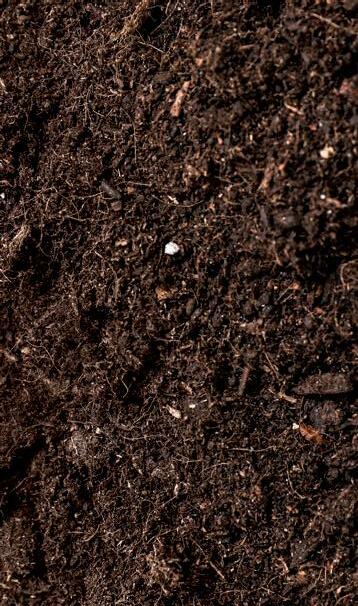
forever.
100% natural, BioGro certified


Supplies readily available source of calcium and sulphate sulphur to support soil health and plant growth.
For more information scan the QR code or go to gypsum.co.nz

Dormancy allows apple trees to survive seasonal changes and protects the meristems from unfavourable climatesFigure 2 Microscope image of a longitudinally dissected Envy apple bud. Floral organs have developed in the bud on the left, whereas the bud on the right is vegetative with no floral organ development
Floral organs have developed in this bud
This bud is vegetative with no floral organ development
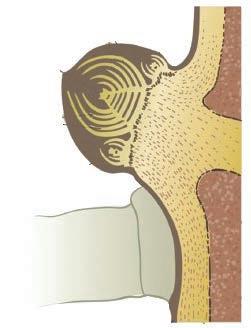
Figure 3 Diagram showing the floral primordia within the bud. Sourced from :https://cdnsciencepub.com/doi/abs/10.1139/cjb2015-0108?mobileUi=0&journalCode=cjb
Budbreak
Following the chilling requirements, a spring warming period is needed to trigger budbreak. In mild winter climates such as New Zealand, occasionally the accumulation requirements of winter chill units may not be met. However, more often the scenario is that the winter chill units may be met, but ‘erratic spring weather’ is experienced, where the consistency of warming may not reach the requirements.
Dormancy breaking sprays can be applied to promote dormancy release and budbreak, and also help to compress the bloom period and synchronise flowering periods for improved pollination.
Timing relative to bud development is vital for the successful application of dormancy breakers. For buds to become responsive to dormancy breakers they already need to have shown some initial swelling. This indicates that the deep dormancy phase in which bud movement is inhibited has passed, and buds are now responding to heat unit accumulation, so given enough heat units they will begin to grow.
Following budbreak in the spring, the young growth undergoes further development from the greentip stage until the terminal flower opening. During this time, the external flower organs complete their final development. Then, once successfully pollinated, a fruit will begin to form from the expanding ovary at the base of the flower.
The fruitlet undergoes rapid cell division, followed by cell expansion. Apples will naturally flower heavily as a survival mechanism and therefore there is the potential for much higher fruit numbers than what is desired at harvest. Removal of these through chemical and hand thinning is important to avoid overcropping the tree. Fruit size is highly dependent on cell numbers therefore thinning is required to reduce the risk of limiting size potential due to excess competition. Additionally, the buds for next season’s crop will also be developing alongside the current crop’s fruitlets. As stated above, the hormones produced by the seed load also has an impact on the proportion of buds which undergo floral induction and development.
Understanding the physiology of trees as they go through their key lifecycle stages, growers can better time their management inputs, such as pruning, dormancy breaker application, and thinning.
 Figure 4 Budbreak has occurred, and these apple buds are now at the greentip stage
Leaf petiole
Phloem Xylem
Pith
Diaphragm
Figure 4 Budbreak has occurred, and these apple buds are now at the greentip stage
Leaf petiole
Phloem Xylem
Pith
Diaphragm
Gypsum is composed of calcium sulphate and allows the slow release of equal portions of both sulphur and calcium in a way that plants can most easily absorb and utilise these nutrients.
Calcium affects mineral uptake and is one of the first nutrients to be balanced in the soil.
Calcium governs cell wall strength, plant resilience as well as plant growth, fruit quality and storage. Good fruit quality requires that adequate amounts of calcium are constantly available to plant roots throughout the season. Sulphur is part of an enzyme used in metabolising nitrates and in the production of quality proteins in plants.1
“Incorporating annual gypsum applications in fertiliser programmes aids to increase soil porosity, soil aeration and drainage. Healthy roots are important too for good leaf size in early spring and to size new fruit from late spring onwards”, says Lindsay Heard of Brenmark Horticultural Consultants.
The physical improvements gypsum can make to soil structure, particularly drainage and aeration, will assist in reducing the severity and incidence of Phytophthora infections or root rot diseases, particularly in avocados.
The Soil Science Society of America notes that gypsum is a moderately soluble mineral so the calcium can move further down the soil profile. The calcium in gypsum increases the precipitation of aluminium and inhibits aluminium uptake by plant roots in acidic soils, promoting deeper rooting plants. When roots are more abundant and can grow deeper into the soil profile, they can take up more water and nutrients, even during the drier periods of a growing season.
Gypsum is called the clay breaker as the sulphate bonds with excess magnesium in the soil, creating magnesium sulphate, which is easily leached from the root profile. The correct ratios of magnesium, calcium and potassium will allow soils to breathe and increase water infiltration and drainage through the soil profile.
You can refer to the percent base saturation on your soil lab test report, as a rough guide to the calcium levels in your soil. Calcium should be between 60 and 80 percent, magnesium between 10 and 20 percent and potassium around three to five percent. This will depend on soil type, as a clay soil can hold higher levels of calcium than a sandy soil. It will also vary according to the fruit crop. Talk to your advisor for further information and guidance.
Lindsay Heard comments, “I have been formulating fertiliser programmes for avocados for more than 20 years and for kiwifruit for more than 30 years and have observed increased growth rates following good maintenance gypsum applications in young avocado blocks.”
Gypsum has multiple benefits in orchard situations and is BioGro certified.
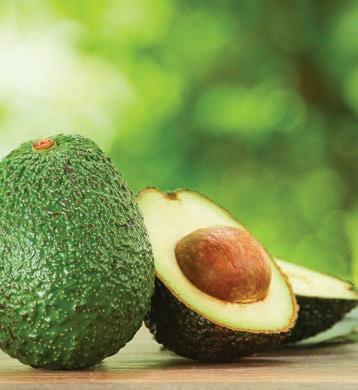
Gypsum is called the clay breaker as the sulphate bonds with excess magnesium in the soil, creating magnesium sulphate, which is easily leached from the root profile
ADAMA New Zealand has announced the extension of their innovative, web-based thinning predictor BreviSmart® to hard-to-thin apple varieties.
BreviSmart, which recommends the optimum time to apply photosynthesis inhibiting fruitlet thinner Brevis®, was launched in this country in 2020 for use with varieties that are easy or of medium complexity to thin.
ADAMA New Zealand commercial Manager Damian MacKenzie, national lead for Brevis and BreviSmart says the programme’s algorithms now also cover more challenging varieties such as Fuji.
A BreviSmart algorithm for pears will also be available in New Zealand in 2023.
Damian says finding the elusive ‘sweet spot’ between over and under thinning apples has tested even some of this country’s most experienced and successful orchardists. “Hand thinning is labour intensive and expensive. While highly weather dependent plant hormone-based thinners alone had not been working that well for a lot of systems.
“Brevis and BreviSmart were the solutions the market was looking for.
“With BreviSmart we can predict the optimum time to apply Brevis – the best day of application for the best thinning response.”
Backed by extensive data and hard science, and developed in collaboration with growers and industry experts from around the globe, BreviSmart continues to be refined and expanded based on ongoing trials and testing.
The BreviSmart algorithms use in-depth knowledge of the impact of weather and other factors on thinning efficacy, taking into account the effects of night-time temperatures, radiation (sunlight), fruitlet size, and the apple variety.
Weather data and forecasts from The Weather Company, an IBM business, support growers’ decisions on when and how much Brevis to apply. Data for five days (including the day of calculation) is sourced from the weather station closest to each orchard.
A report is then generated, using a traffic light system (yellow for reduced thinning conditions, green for good thinning conditions, red for strong thinning conditions). Reports are produced daily during the thinning season. Over 800 trials worldwide have contributed to the BreviSmart programme to date.
Damian says this ongoing commitment and meticulous approach is paying off. “Growers appreciate the science
BreviSmart brings to the thinning equation. Ultimately, they feel more in control.”
New Zealand orchardists and advisors using the technology have reported that BreviSmart has been an important tool, backing their own gut instinct.
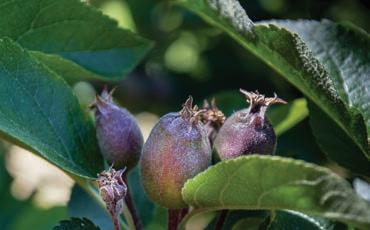

Used in 30 countries worldwide, Brevis is applied when fruitlets are about 8–14 mm in size. Mimicking the effect of shade, Brevis reduces the production of carbohydrates by the tree. Remaining carbohydrates are sent to shoots and the largest, dominant ‘king’ fruitlets at the expense of smaller fruitlets, which start to drop seven to ten days after treatment.
The chemistry is easy to measure for tank mixing, requires no surfactants or other additives, and is rain-fast in two to three hours. Brevis is non-toxic to beneficial organisms.
The predictions generated by BreviSmart are designed to support you and the final recommendations. Please note that these predictions are one of several key factors you need to take into account before building any recommendations.
Registered pursuant to the ACVM Act 1997, No. P9397.
See www.foodsafety.govt.nz for registration conditions. Approved pursuant to the HSNO Act 1996. Approval No. HSR101178. See www.epa.govt.nz for registration conditions.
Larger ‘king’ fruitlets and smaller fruitlets prior to thinning
In recent years, agricultural innovation has been building momentum, helping farmers, growers, and organisations across the food and fibre sector work smarter, not harder.
A globally renowned awards programme, Fieldays Innovation Awards, is hungry for new ideas in the innovation space. Representing the innovation lifecycle in three award categories, Prototype, Early-Stage, and Growth & Scale allows individuals and companies, big or small, to get the support, recognition and mentoring they require to take their innovation to the next level. Special recognition is also given to younger innovators, with an award for the Fieldays Young Innovator of the Year.
Programme Developer for the New Zealand National Fieldays Society, Steve Chappell, says that the ideas nurtured through the Fieldays Innovation Awards are needed now more than ever.
“The landscape is changing rapidly, and innovators are rising to the challenge. “Climate change, labour shortages, and how we will secure ample food and fibre for the world’s growing population are issues that continue to weigh heavily on our industry and can be answered with innovation.”
With a total prize package over $60,000 worth of cash, services and products with tailored opportunities to progress innovations in each award category application, these awards are highly regarded.
The Fieldays Innovation Hub is the platform that showcases these award entrants as well as other innovative problem solvers and creators. The experience of exhibiting in the Fieldays Innovation Hub was “nothing short of life changing,” says Marianne Awburn, co-founder of Springarm
Products, winner of the 2021 Prototype award. “Connecting with our audience and getting a chance for real-life feedback was priceless –we wouldn’t have wanted to launch our product any other way. Winning the award was the icing on the cake!”
Applications for the Fieldays Innovation Awards are always open. The cut-off for applications for the 2022 Awards is 1pm Thursday 6 October 2022. Apply now at: www.fieldays.co.nz/innovation Fieldays 2022 30 Nov – 3 Dec.

Site: Located at the intersection of D Street and M Road, Mystery Creek
Are you ready to see the future? Visit the Innovation Hub to see the latest innovators, inventions, and industry developments all aimed at improving New Zealand’s primary industries.



